

Change the size of your slides
Basic steps.
To change the slide size:
Select the Design tab of the toolbar ribbon.

Select Standard (4:3 aspect ratio) or Widescreen (16:9) or Custom Slide Size .
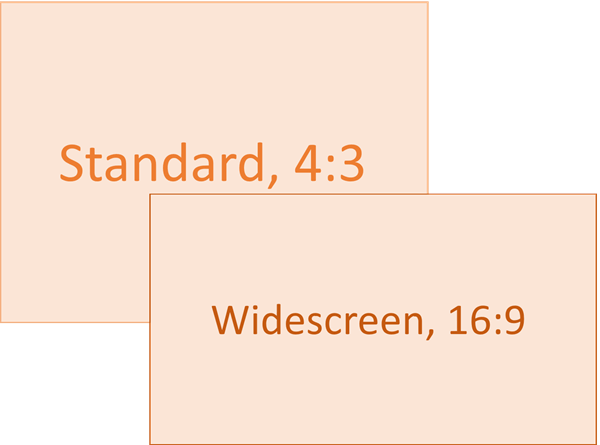
For more about the predefined sizes (including formats like Overhead, A3, A4, Banner, B4, and B5) or your own custom sizing, click a heading below to expand it and see the details .
Detailed steps
Choose the standard or widescreen slide size.
On the Design tab of the Ribbon, locate Slide Size in the Customize group, near the far right end of the toolbar.

Select Slide Size , and then select either Standard (4:3) or Widescreen (16:9) .
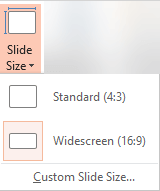
When PowerPoint is unable to automatically scale your content, it prompts you with two options:
Maximize : Select this option to increase the size of your slide content when you are scaling to a larger slide size. Choosing this option could result in your content not fitting on the slide.
Ensure Fit : Select this option to decrease the size of your content when scaling to a smaller slide size. This could make your content appear smaller, but you’ll be able to see all content on your slide.

The 16:9 widescreen setting is the default value for new presentations you create. When you change the slide size for a presentation, the size you choose only applies to that presentation. However, you can make it easy to create a new 4:3 presentation for yourself whenever you want—by defining a custom theme that uses the 4:3 aspect ratio. See the section below named "Make a default size to start from when creating new presentations."
Choose another size, such as A3, B4, or Overhead
Select Slide Size , and then select Custom Slide Size .
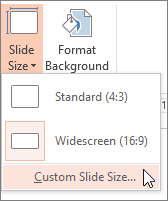
In the Slide Size box, click the down arrow next to Slides sized for and select an option. Their dimensions are listed below:
Overhead provides an aspect ratio very close to the standard 4:3 slide size.
There are two options for 16:9 aspect ratios:
On-screen Show (16:9) sets the slide dimensions to 10 in x 5.625 in.
Widescreen sets it to 13.333 in x 7.5 in.
Both of these options are the same aspect ratio so they will look the same in Normal View , since PowerPoint automatically adjusts the zoom level. Widescreen (13.333 in x 7.5 in.) provides more slide surface area for the content, so that is the best choice for presentations. Widescreen won’t fit on an 8.5" x 11" sheet of paper without you having to scale it down.
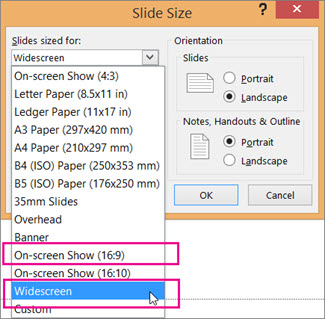
Select OK to accept the dimensions and close the Slide Size dialog box.
Choose custom dimensions (in inches, centimeters, or pixels)
The Slide Size dialog box opens.
In the Slide Size dialog box, ensure the orientation is set the way you want it.
In the Height and Width boxes, PowerPoint accepts measurements in inches , centimeters , or pixels . Type a number followed by a space and then the appropriate abbreviation: in , cm , or px .
PowerPoint then converts measurements, if necessary, to the type of unit your operating system uses.
You can change the unit of measure that is shown in PowerPoint dialog boxes if you like.
Make a default size to start from when creating new presentations
This version of PowerPoint has a default size of 16:9 for new presentation, but you can create a different default for yourself.
Start PowerPoint.
On the File tab of the toolbar ribbon, select New . Then double-click the Blank Presentation to create a new, empty presentation.
Then on the Design tab, click Slide Size and choose the size you want for a default.
(If you want a different default slide size than what's listed there, select Custom Slide Size and then choose your size in the Slide Size dialog box, and then click OK .)

Select Save Current Theme .
Give your theme a name that you'll remember easily and click Save . Don't change the folder that the new theme is to be saved in.
On the Design tab, click the More arrow again in the bottom-right corner of the Themes group. You'll see your newly saved theme under a Custom heading.
Right-click that new custom theme under the Custom heading, and then select Set as Default Theme :

Close PowerPoint. Don't save any files if it prompts you.
Open PowerPoint again. On the File tab of the toolbar ribbon, select New .
The custom theme that you just saved is listed at the top left corner, named Default Theme . The thumbnail image looks like a widescreen slide, but in reality, when you create a new presentation based on that theme, the presentation has the aspect ratio that you've defined for this default theme.
The next time you open PowerPoint, you'll see your default theme in the upper-left of the theme gallery. When you select it, all the slides will be the custom size you chose by default.
Sizing applies to all slides in a presentation
PowerPoint isn't able to resize one slide within a presentation. All slides in a presentation are the same size.
If this is a feature you’d like to request, please send us your feedback to help us prioritize new features in future updates. See How do I give feedback on Microsoft 365 for more information.
Orientation applies to all slides in a presentation
PowerPoint isn't able to change the page orientation of certain slides. All slides in a presentation have the same page orientation.
Change the page orientation in PowerPoint between landscape and portrait
Use portrait and landscape slide orientation in the same presentation
Reduce the file size of a picture
On the File menu, select Page Setup .
In the Page Setup dialog box, under Slides sized for , select the predefined size you want, or choose Custom and specify the dimensions you want.

Select Slide Size .

Select Standard (4:3) or Widescreen (16:9) .
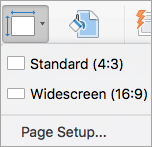
PowerPoint may prompt you about scaling your content. Choose one of the following options:
Scale: Select this option to decrease or increase the size of your slide content. When scaling to a smaller slide size, this could make your content appear smaller, but you’ll be able to see all content on your slide.
Don't Scale: Select this option to maintain the size of your slide content. Choosing this option could result in your content not fitting on the slide.
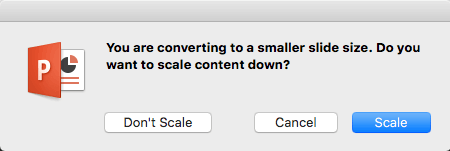
Choose Page Setup from the menu that appears.
Page Setup gives you an assortment of predefined slide/page size options. The options and their dimensions are listed below:
In the Slide Size box, click the down arrow next to Slides sized for and select an option.
Widescreen sets the dimensions to 13.333 in x 7.5 in.
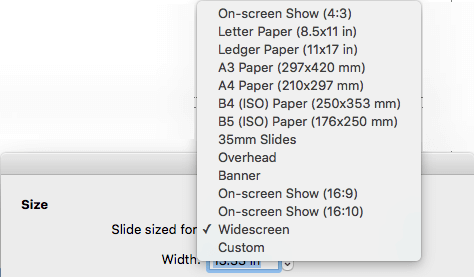
Choose custom dimensions (in inches, centimers, or pixels)
Select Slide Size , and then click Page Setup .
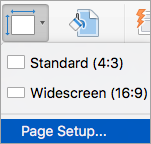
The Page Setup dialog box opens.
In the Width and Height boxes, PowerPoint accepts measurements in inches , centimeters , or pixels . Type a number followed by a space and then the appropriate abbreviation: in (inches) or cm (centimeters) or px (pixels).
PowerPoint then converts the measurements, if necessary, to the unit of measurement your operating system uses.
Make a new slide size the default for new presentations
Select Slide Size , and then select Page Setup .
Follow the steps in the prior section to choose the slide size you want.
On the Design tab, click the More arrow below the standard themes.
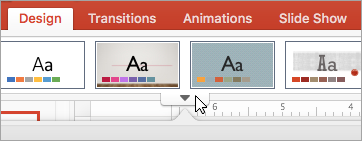
Click Save Current Theme at the bottom of the window.
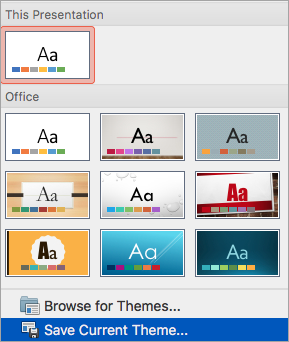
Give your theme a name that you'll remember easily and click Save .
On the Design tab, click the More arrow below the standard themes again. You'll see your newly saved theme under Custom .
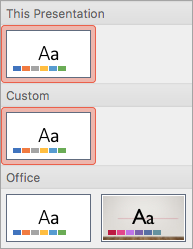
Right-click your new custom theme, and then click Set as Default Theme .
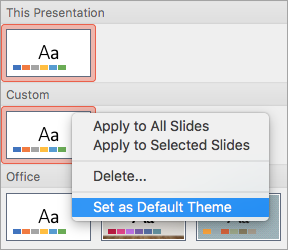
The next time you open PowerPoint, you'll see your default theme in the upper-left of the theme gallery. When you select it, all the slides will be the size you chose for your default theme.
Some folks have asked about resizing one slide within a presentation. PowerPoint isn't able to do that. All slides in a presentation are the same size.
Some folks have also asked about changing the page orientation of certain slides. PowerPoint isn't able to do that. All slides in a presentation have the same page orientation.
On the Design tab of the toolbar ribbon, click Slide Size in the Customize group.
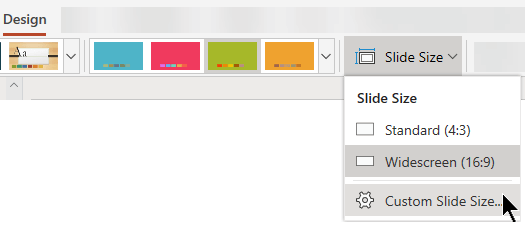
Click Standard (4:3) or Widescreen (16:9) .
When PowerPoint for the web is unable to automatically scale your content, it prompts you with two options:
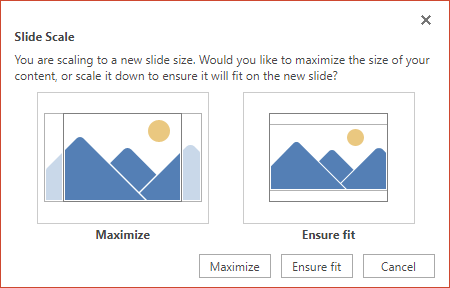
The 16:9 widescreen setting is the default value for new presentations you create. When you change the slide size for a presentation, the size you choose only applies to that presentation.
You can also change the orientation of all the slides in your presentation. See Change the page orientation for instructions.
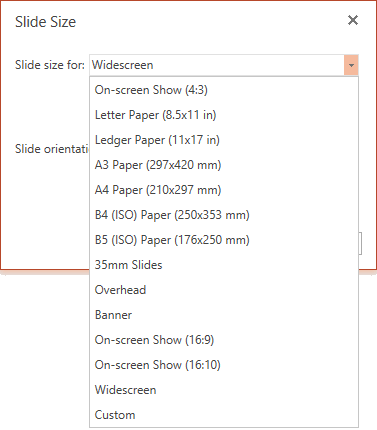
Choose custom dimensions
In the Width and Height boxes, type a measurement in inches . PowerPoint doesn't accept measurements outside the minimum and maximum shown below:

Need more help?
Want more options.
Explore subscription benefits, browse training courses, learn how to secure your device, and more.

Microsoft 365 subscription benefits

Microsoft 365 training

Microsoft security

Accessibility center
Communities help you ask and answer questions, give feedback, and hear from experts with rich knowledge.

Ask the Microsoft Community

Microsoft Tech Community

Windows Insiders
Microsoft 365 Insiders
Was this information helpful?
Thank you for your feedback.
How-To Geek
How to change slide size in powerpoint.
PowerPoint allows you to change your presentation's slide sizes, which you may need to do to change how your slides are displayed or printed. Here's how.
Quick Links
Changing powerpoint slide sizes, changing to a custom powerpoint slide size.
PowerPoint allows you to format and present the content of your slides in different ways. If you want to print out or display your PowerPoint slides in a bigger or smaller-than-average size, you can change the slide sizes to match.
PowerPoint has two common slide sizes. The first, 4:3, is a good option if you're using older hardware to present your slides. If you're planning on presenting your PowerPoint presentation using a modern projector or display, then the 16:9 slide size should be your preferred choice.
By default, PowerPoint will default to the 16:9 side slide. To print your slides (full size, one per page), you'll likely need to use a custom slide size, rather than one of these options.
Switching to another size is thankfully an easy process---open your PowerPoint presentation to begin and then click the "Design" tab on the ribbon bar.
In the "Customize" section of the "Design" tab, select the "Slide Size" button. This will display the two common slide sizes in a drop-down menu.
Click either the "Standard (4:3)" or "Widescreen (16:9)" option to switch all of your PowerPoint slides to that size.
Unfortunately, it isn't possible to use multiple slide sizes in a PowerPoint presentation. Just as if you were making PowerPoint slides vertical , any changes you make to your PowerPoint slide sizes will apply to all slides.
Related: How to Make Slides Vertical in PowerPoint
It's possible to use a custom PowerPoint slide size if the default 4:3 or 16:9 options are unsuitable. You might choose to use a custom slide size if you're printing full-size PowerPoint slides using a custom page layout, for instance.
To do this, select Design > Slide Size > Custom Slide Size to display the "Slide Size" options menu.
Various preset slide sizes, such as A3 or A4 paper sizes, are shown under the "Slides Sized For" drop-down menu.
Select one of these preset options, or set your slide dimensions manually using the "Width" and "Height" option boxes. From there, click the "OK" button to save.
If you're scaling down to a smaller size, PowerPoint will ask you how it should handle any slide content.
Choose "Maximize" if you want the slide contents to remain at a similar scale, but with the risk that some of the content may be cut. Alternatively, click "Ensure Fit" to scale the slide contents down in size to match the new slide size without losing any content.
Once saved, the custom slide size you selected will be immediately applied to all of your slides, with slide content being resized or cut to match.
Critical PowerPoint Shortcuts – Claim Your FREE Training Module and Get Your Time Back!

How to Change Your PowerPoint Slide Size (16:9 vs. 4:3)
- PowerPoint Tutorials
- March 10, 2019
In this tutorial, you’ll learn how to change your slide size in PowerPoint.
That way you can create slides for any situation including on-screen presentations, printed documents, posters, postcards, handouts, etc.
First off, the two most used PowerPoint slide sizes are:
- 16:9 ratio for onscreen presentations and new overhead projectors. This is the default setting for the latest versions of PowerPoint.
- 4:3 ratio for printing slides on standard 8.5 x 11 pieces of paper as handouts.
When starting with a blank PowerPoint presentation, changing your slide size is super easy and straightforward. If not, there are a few issues you’ll need to deal with, each covered below.
That’s why it’s worth figuring out what slide size you need BEFORE you build your presentation. If you later convert your presentation to a different size, it can be painful!
It’s just like the old carpenter saying, “measure twice and cut once.” In PowerPoint, you’ll want to “ask twice (to double confirm the required size) and build once.”
Changing your PowerPoint slide size does not make your PowerPoint presentation larger or smaller. To reduce your PowerPoint file size, you need to learn how to compress a PowerPoint presentation .
Table of Contents
How to change your powerpoint slide size.
By default, new PowerPoint presentations start in the 16:9 slide size format.
This is the NEW standard for most modern overhead projects and monitors and is recommended for most presentations. That said, you can easily change your slide size to something else.
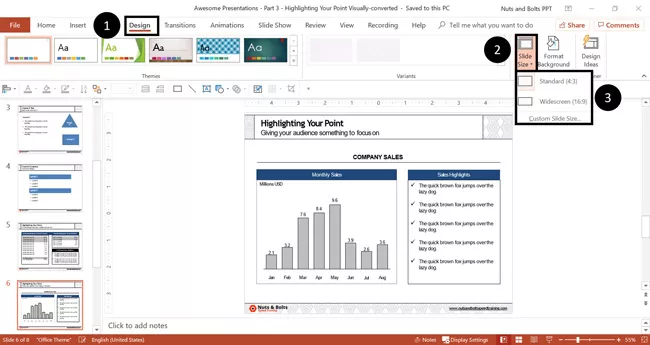
To change your slide size in PowerPoint, simply:
- Navigate to the Design tab
- Open the Slide Size drop down menu
- Select 4:3 , 16:9 or Custom Slide Size (see options below)
When starting with a blank presentation, you are now good to go. You will not have to worry about any of the conversion issues discussed below.
Notice too, how much wider the 16:9 slide size is versus the 4:3 slide size in the picture below. The new size gives you more room for the content on your slides.
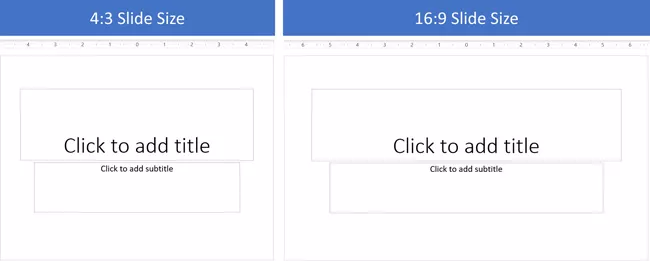
When you are converting an existing presentation to a new slide size, you will additionally be given the following prompt:
“You are scaling to a new slide size. Would you like to maximize the size of your content, or scale it down to ensure it will fit on the new slide?
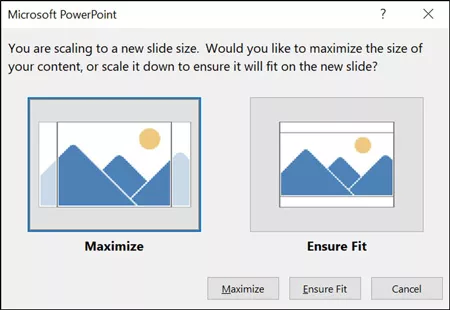
Maximize leaves all your content as is on your slide, even if it no longer fits on the new slide size that you selected.
Ensure Fit scales down your content in proportion to the new slide size you have selected. You will only see this option when moving from a larger slide size to a smaller one.
Custom PowerPoint slide sizes
Choosing Custom for your slide size gives you additional options to work with. Inside the dialog box you can choose your size on the left and your orientation on the right.
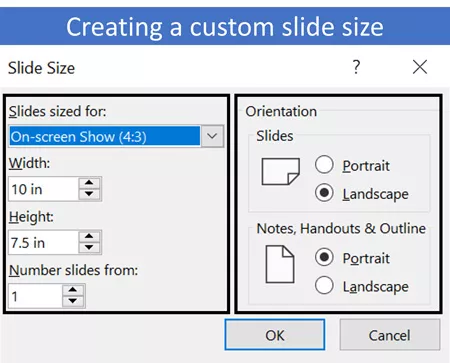
On top of that, you can also input your own custom slide size. However, I recommend using one of the preset PowerPoint dimension options.
- On-screen show (4:3)
- Letter Paper (8.5×11 in)
- A3 Paper (297×420 mm)
- B4 (ISO) Paper (250×353 mm)
- B5 (ISO) Paper (176×250 mm)
- 35mm Slides
- On-screen Show (16:9)
- On-screen show (16:10)
For your orientation options on the right-hand side of the dialog box, you can choose between Landscape and Portrait .
In most situations, you will want one of the default settings. Best practice is Landscape for your presentation slides and Portrait for your printed notes, handouts and outlines.
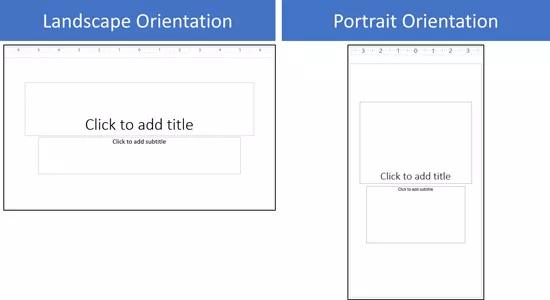
Issues when converting 4:3 to the 16:9 slide size in PowerPoint
When converting an existing 4:3 presentation with content into the 16:9 format, you are not given any conversion options. Instead, PowerPoint simply does the conversion for you, which can create several problems.
There are two issues you will face in the new 16:9 slide size.

The first issue is that all the images on your slide master (including company logos) will be stretched to fit the new, larger slide size.
To fix the stretched images, you will need to fix those images (or reinsert them) on your slide master, as if you were creating a PowerPoint template from scratch.
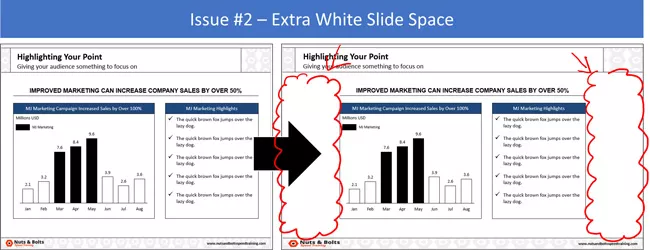
The second issue you will face in the larger 16:9 slide size is that you will have a lot of extra white space on your slides.
While you can leave the space blank, doing so will make your content look weird. Ideally you don’t want a lot of white empty space like that on your slides. Especially since all your font sizes will be so small.
That’s why if you have the time, I recommend resizing your content to fill in the white space. You can do this by either increasing the font size of your content, or adding additional visuals that support your message.
Issues when converting 16:9 to the 4:3 slide size in PowerPoint
When converting an existing 16:9 presentation to the 4:3 slide size, you are given the option to either Maximize or Ensure Fit (both covered below).
1. The Maximize option
This option means that the content on your slides will not be resized to fit the 4:3 slide size. The same is true if you move to any smaller slide size.
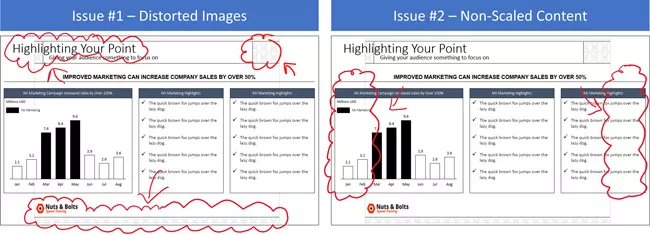
Maximize Issue #1: All the images on your slide master (including your company logo) will be distorted.
You might also have issues with other content placeholders, slide backgrounds or anything else that was built on your slide master. For these issues, you’ll first need to navigate to your Slide Master. Once you are there, you either adjust (or rebuild) your PowerPoint template so that everything fits properly.
Maximize Issue #2: Your content will not be scaled down to the smaller slide size. Instead, you’ll have overhanging content as pictured above.
For these kinds of spacing issues, you will need to work through your slides to adjust your content.
One recommendation as you move from the larger 16:9 slide size to 4:3, is to break up your slides. Take the contents from one larger slide and break it into two (or even three) separate slides.
Breaking up your content is preferable to just cramming more content on the smaller slide space. Doing so will make your content easier to read when presented on an overhead projector.
2. The Ensure Fit option
This option means that PowerPoint will scale down your content to fit the smaller slide size based on the size you selected.
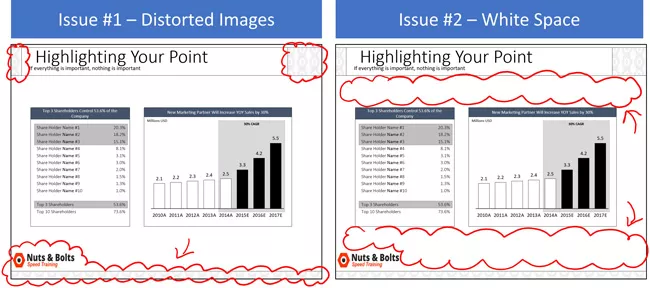
Ensure Fit Issue #1: Distorted images, slide backgrounds and anything else that PowerPoint had to automatically resize on your slide master.
To fix these issues, you’ll need to navigate to your slide master and adjust (or rebuild) your template to make everything fit.
Ensure Fit Issue #2: Your content will be scaled down to fit your new slide size, leaving you with a lot of white space. In addition, all your font sizes will be smaller, making them hard to read.
For small content like this, you’ll need to work through your slides and resize your content accordingly. Keep in mind the people at the back of the room too when choosing a new font style and size.
Saving your custom slide size as a PowerPoint theme
If want to use your own custom slide size for all your future PowerPoint presentations, you can save and set it as a PowerPoint theme.
This is a two-step process as discussed below.
1. Save your custom slide size as a theme
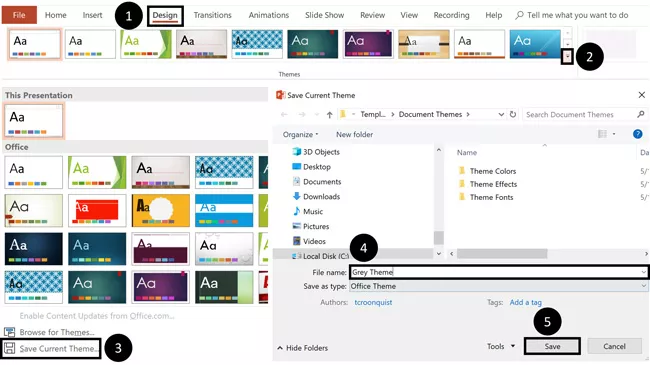
To save your custom slide size (and settings) as your own custom PowerPoint theme, simply:
- Open the M ore options
- Click Save Current Theme
- Name your Theme (and don’t change the file location it saves to)
- Click Save
2. Set your custom theme as the default
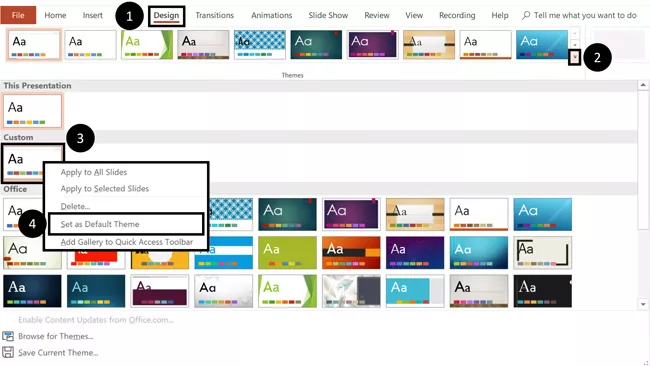
To set a custom PowerPoint theme as the default for all your future presentations, simply:
- Open the More options
- Right-click your custom theme
- Select Set as Default Presentation
- Close out of PowerPoint (and do not save any presentations if it prompts you)
Once you’ve set your own custom theme as the Default Presentation, it will open every time you start PowerPoint. This saves you from always having to switch your slide sizes.
So that’s how you can change your PowerPoint slide size, either before or after you create your presentation.
And although you are given a lot of flexibility in the slide sizes you can choose from, I recommend using the default slide sizes as used by most people.
It’s also important to remember that switching slide sizes after you have built your presentation can be a total pain. So, to the extent possible, figure out your PowerPoint slide size first before you build out your presentation.
If you enjoyed the depth of this article, you’ll love our PowerPoint training courses and other free resources that you can learn more about here .
🔒 Unlock the PowerPoint Shortcuts Trusted by Industry Leaders KKR, American Express, HSBC, and More!
Join over 114,880 professionals from diverse fields including consulting, investment banking, advertising, marketing, sales, and business development who have supercharged their PowerPoint game with our proven methods.
✅ Customize compelling presentations effortlessly.
✅ Master time-saving techniques for faster deck creation.
✅ Boost your career prospects with top-notch PowerPoint skills.
Get FREE access to the Critical PowerPoint Shortcuts module of our premium training course by entering your name and email below.
DISCLAIMER: PC Users Only!
We respect your privacy and will keep your info safe and confidential.
Related Articles
About the author.
Popular Tutorials
- How to Strikethrough Text (l̶i̶k̶e̶ ̶t̶h̶i̶s̶) in Word, Excel & PowerPoint
- How to Make Animated Fireworks in PowerPoint (Step-by-Step)
- Strikethrough Shortcut (l̶i̶k̶e̶ ̶t̶h̶i̶s̶) for Word, Excel & PowerPoint
- How to Create a Flash Card Memory Game in PowerPoint (Like Jeopardy)
- Keyboard Shortcuts Not Working: Solved
PowerPoint Tutorial Categories
- Strategies & Opinions
- Shortcuts & Hacks
- Presentation Design
- Pictures, Icons, Videos, Etc.
- New Features
- Miscellaneous
- Charts & Data Viz
We help busy professionals save hours and gain peace of mind, with corporate workshops, self-paced courses and tutorials for PowerPoint and Word.
Work With Us
- Corporate Training
- Presentation & Template Design
- Courses & Downloads
- PowerPoint Articles
- Word Articles
- Productivity Resources
Find a Tutorial
- Free Training
- For Businesses
We help busy office workers save hours and gain peace of mind, with tips, training and tutorials for Microsoft PowerPoint and Word.
Master Critical PowerPoint Shortcuts – Secure Your FREE Training Module and Save Valuable Time!
⌛ Master time-saving expert techniques.
🔥 Create powerful presentations.
🚀 Propel your career to new heights.
We value your privacy – we keep your info safe.
Discover PowerPoint Hacks Loved by Industry Giants - KKR, AmEx, HSBC!
Over 114,880 professionals in finance, marketing and sales have revolutionized their PPT skills with our proven methods.
Gain FREE access to a full module of our premium PowerPoint training program – Get started today!
We hate spam too and promise to keep your information safe.
Next Gen Data Learning – Amplify Your Skills

How to Adjust Slide Size in PowerPoint: A Quick & Easy Guide
by Enterprise DNA Experts | PowerPoint

Ever started making a presentation in PowerPoint, only to realize that the slides are too small, or too big?
It’s happened to the best of us.
The good news is, adjusting the slide size in PowerPoint is a simple process that can help you avoid this problem and create presentations that look just right.
To adjust the slide size in PowerPoint, click on the “Design” tab, and then “Slide Size.” You can choose from two standard slide sizes, either “Standard (4:3)” or “Widescreen (16:9).” Additionally, you can also choose a custom slide size by entering the dimensions manually.
In this article, we’ll take you through the steps of adjusting the slide size in your presentation.
You’ll also learn about the various options available for slide size, and why it’s important to choose the right one for your presentation.
Let’s get started!

Table of Contents
What is Slide Size in PowerPoint?
Slide size in PowerPoint refers to the dimensions of a single slide in a presentation. It determines the width and height of the slide and can be customized to fit different screen aspect ratios and output formats.

Aspect Ratio: This is the proportional relationship between the width and height of a slide. The two most common aspect ratios for slides are 4:3 (standard) and 16:9 (widescreen).
Remember, the aspect ratio you choose will depend on the intended display or output format of your presentation.
Output Format: The slide size can be adjusted based on the output format you plan to use. For example, if you’re creating a presentation for a standard projector, you might choose a 4:3 aspect ratio.
On the other hand, if your presentation will be displayed on a widescreen TV or uploaded to an online platform, a 16:9 aspect ratio is typically recommended.
By customizing the slide size, you can ensure that your actual presentation looks its best on various devices and platforms.

2 Ways How to Adjust the Slide Size in PowerPoint
There are two ways to adjust the slide size in your presentation: using the default settings or customizing the size to meet your specific needs.
1. How to Adjust Slide Size Using the Default Settings
If you are using PowerPoint 2013 or later, you can adjust the slide size using the default settings.
Here’s how to do it:
Open your PowerPoint presentation.
Click on the “Design” tab in the Ribbon menu.
In the “Customize” group, click “Slide Size.”
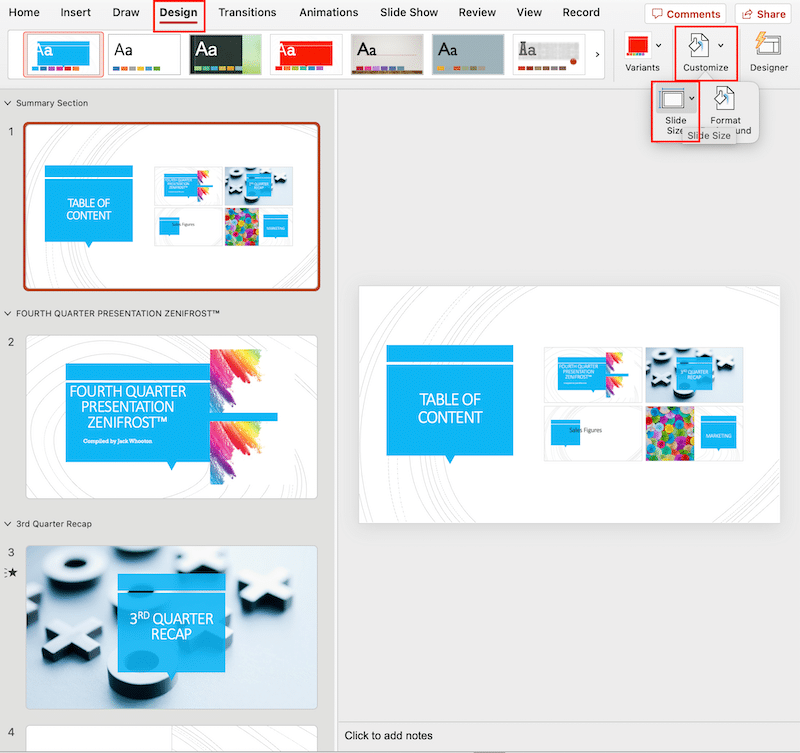
Choose either “Standard (4:3)” or “Widescreen (16:9)” from the drop-down menu.
PowerPoint will adjust the slide size according to your selection.
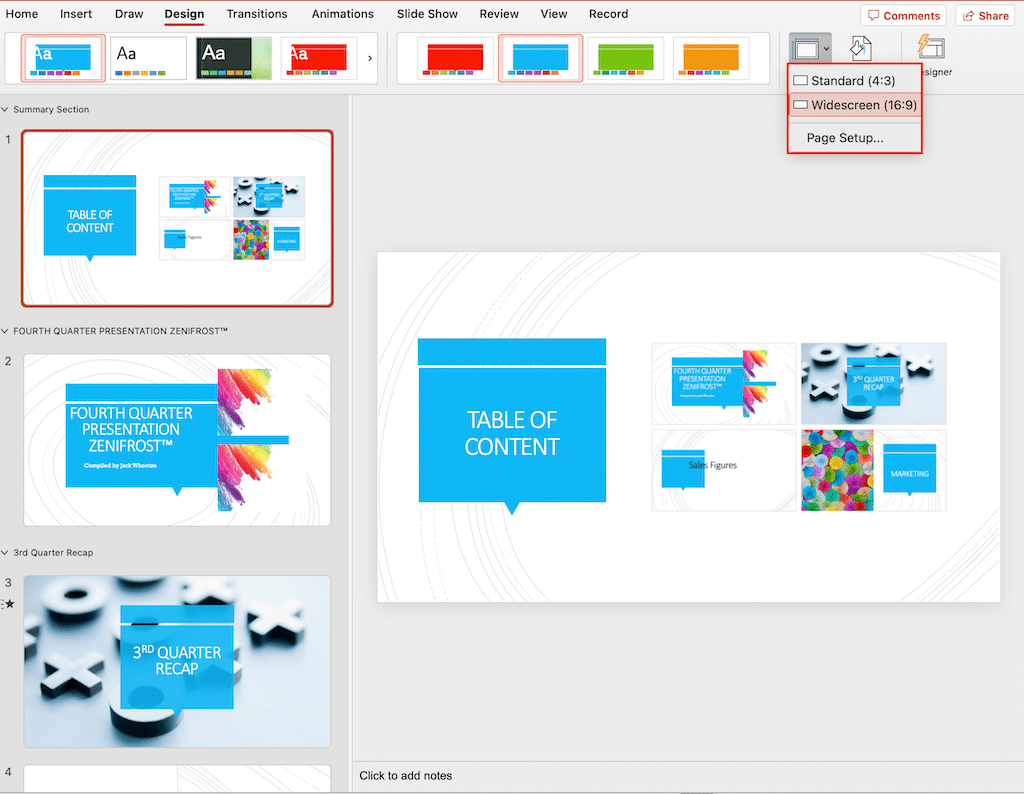
Note: In PowerPoint 2010 and earlier versions, the “Design” tab is called the “Page Layout” tab. The steps are the same.
Now that you’ve learned how to adjust the slide size using the default settings, let’s move on to customizing the size to fit your specific needs .
2. How to Adjust Slide Size by Customizing It
If you have specific slide dimensions in mind for your presentation slides, you can easily customize the slide size in your presentation.
Follow these steps:
Open your presentation.
In the “Customize” group, click “Slide Size” and then select “Custom Slide Size” or “Page Setup”.
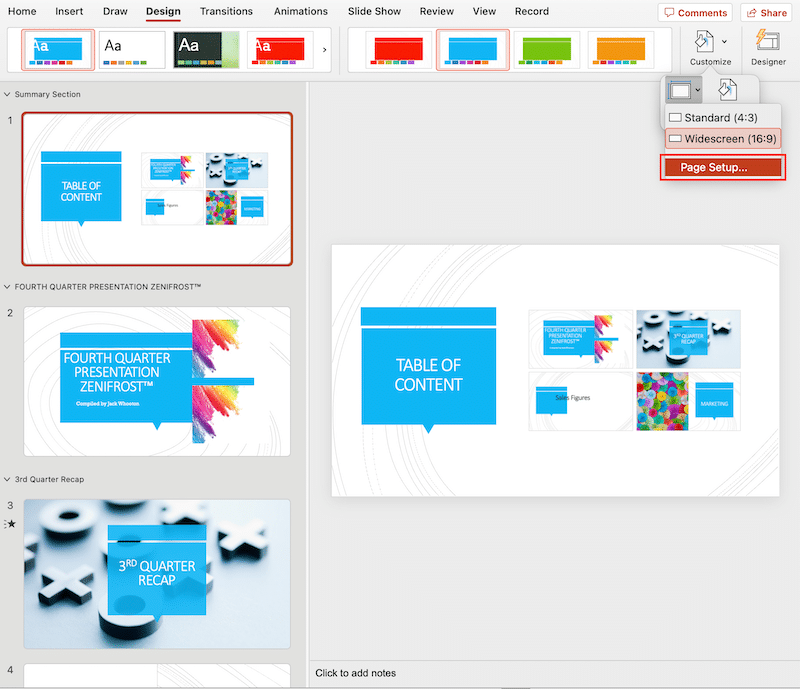
In the “Slide Size” dialog box, you can choose from a list of pre-defined slide sizes, including “On-screen Show,” “Letter Paper,” “A4 Paper,” and more. Alternatively, you can enter custom width and height values in the “Width” and “Height” boxes.
Click “OK” to apply your custom size.
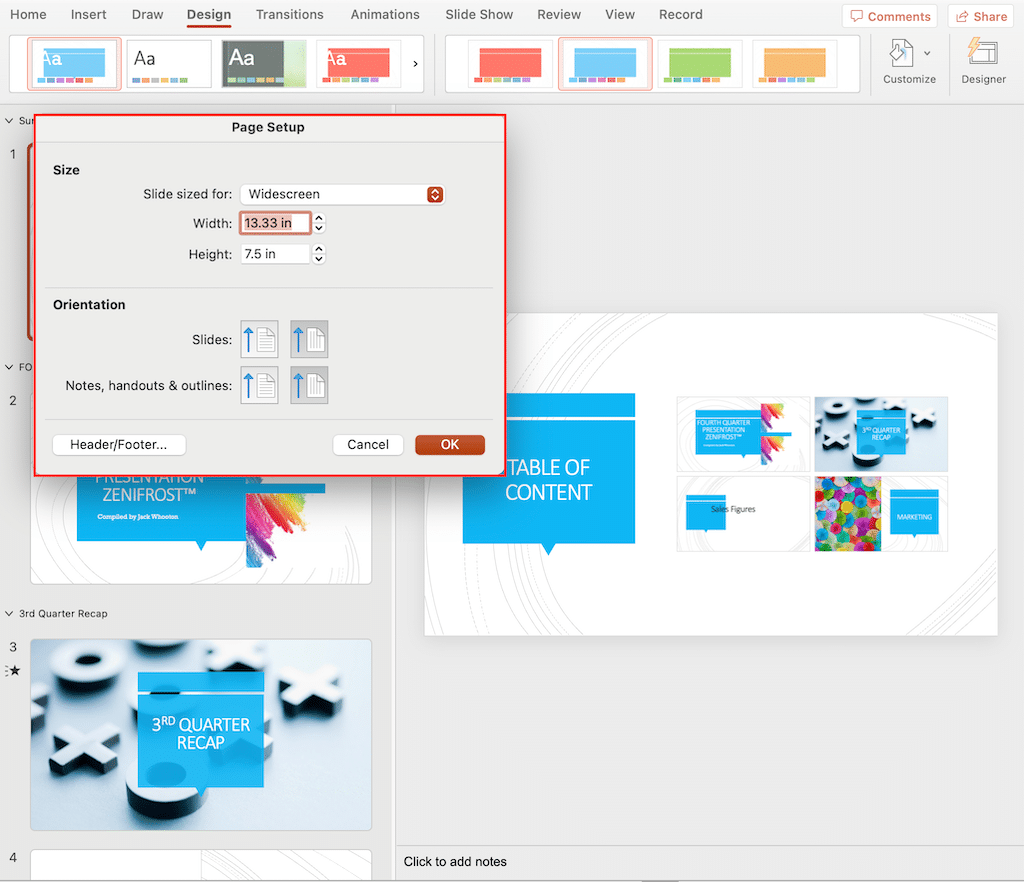
Now that you’ve learned how to adjust the slide size in your presentation, let’s take a look at the different options available for slide size.
Options for Slide Size in PowerPoint
When you’re creating a presentation in PowerPoint, you have a few different options for the slide size . You can choose between the standard size (4:3) and the widescreen size (16:9).
Let’s take a closer look at these options and when you might want to use each one.

1. Standard Size (4:3)
The standard size in PowerPoint is a 4:3 aspect ratio. This means that for every 4 units of width, there are 3 units of height. It’s the traditional size for older television screens and projectors.
The 4:3 aspect ratio provides a more square-shaped slide orientation, which can be beneficial for certain types of content, such as:
Printed handouts
Vertical designs
Content intended for older display systems
Certain templates and design layouts
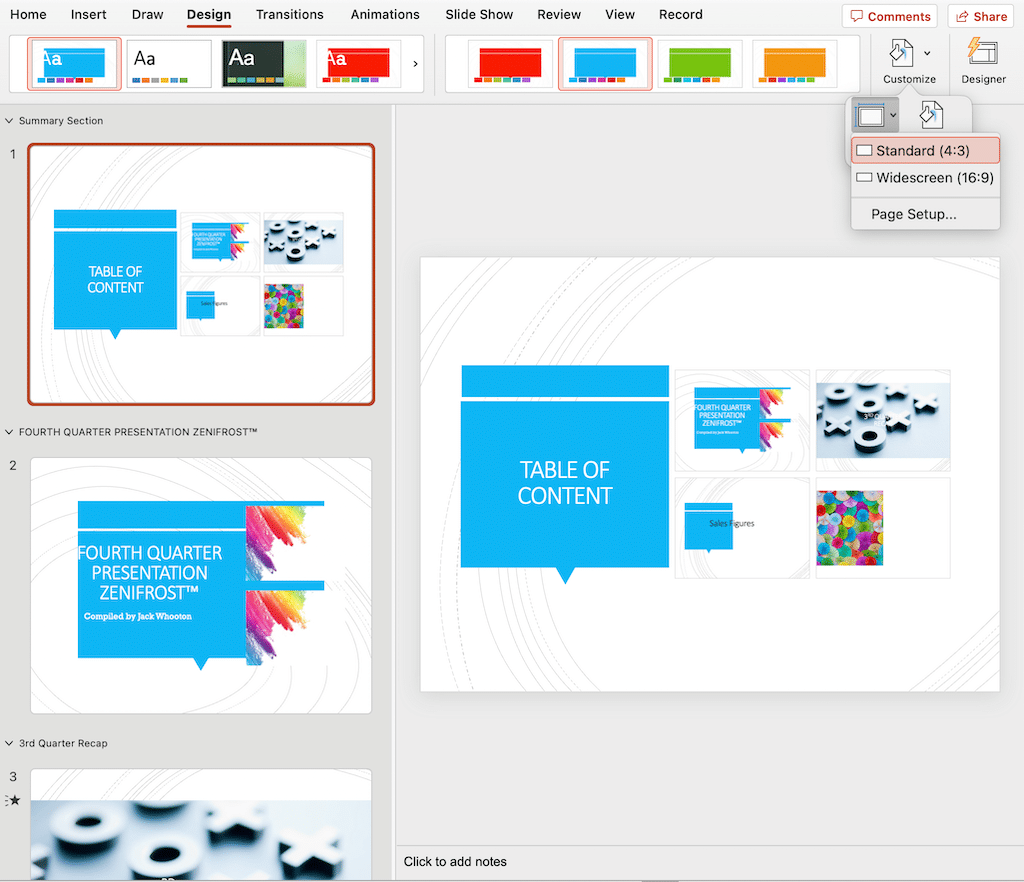
2. Widescreen Size (16:9)
The widescreen slide size in PowerPoint is a 16:9 aspect ratio. This means that for every 16 units of width, there are 9 units of height. It’s the standard size for most modern high-definition displays, including computer monitors, TVs, and projectors.
The 16:9 aspect ratio provides a more rectangular-shaped slide orientation, which can be beneficial for certain types of content, such as:
Video content
Web-based presentations
Screen sharing
Detailed images
Presentations that need to be compatible with a wide range of devices
Now that you’ve learned about the two main options for slide size for your presentation, let’s discuss why it’s important to choose the right one for your presentation.

Why Choose the Right Slide Size in PowerPoint?
Choosing the right slide size is crucial for creating an effective and professional-looking presentation. The size of your slides not only affects the layout and design but also influences how your content is displayed on different screens and devices.

Here are some key reasons why you should carefully consider your slide sizes:
Optimized content layout: The size of your slides will determine how much content can be displayed at once. A larger slide size, such as widescreen (16:9), allows for more space to work with, enabling you to create visually appealing and uncluttered layouts.
Consistency across devices: By selecting one slide size, you can ensure that your presentation will look consistent and well-proportioned when viewed on various devices , including laptops, projectors, and large displays.

Enhanced readability: Larger slides provide more room for text and images, making it easier for your audience to read and understand your content, even from a distance.
Professional appearance: A carefully chosen slide size demonstrates attention to detail and a commitment to delivering a high-quality presentation. It can also help you stand out as a professional and competent presenter.
Now that you understand the importance of choosing the right slide size for your presentation, let’s review the steps you can take to adjust it in your own PowerPoint presentations.

Final Thoughts
Learning how to adjust the slide size in PowerPoint can significantly enhance the quality of your presentations. By understanding the various options available and making the right choice, you can ensure that your content is well-organized, visually appealing, and consistent across different devices and screens.
So, whether you need a standard 4:3 aspect ratio or a widescreen 16:9 format, PowerPoint makes it easy to customize the slide size to meet your specific needs.
Furthermore, this flexibility allows you to create professional and polished presentations that leave a lasting impression on your audience.

So, the next time you start working on a presentation, remember the importance of slide size and use the knowledge you’ve gained here to make the right choice. Happy presenting!
If you want to learn more about using Powerpoint to enhance the visuals of your data analysis, check out our video below:
Frequently Asked Questions
How can i change the slide size in my powerpoint presentation to a4.
To change the slide size to A4, follow these steps:
In the “Customize” group, click “Slide Size” and then “Custom Slide Size.”
In the “Slide Size” dialog box, select “A4 Paper” from the “Slides sized for” dropdown menu.
Click “OK” to apply the A4 slide size.
What is the standard slide size in PowerPoint?
The standard slide size in your presentation is 10 inches by 7.5 inches, which is a 4:3 aspect ratio. However, with newer versions of PowerPoint, the default slide size is 13.333 inches by 7.5 inches, also a 4:3 aspect ratio.
How do I set custom dimensions for my PowerPoint slides?
To set custom slide dimensions for your PowerPoint slides, follow these steps:
In the “Slide Size” dialog box, enter your desired width and height in the “Width” and “Height” boxes.
Click “OK” to apply the custom slide size.
Repeat steps 1-4 for all the slides or selected slides only. You can then proceed to number slides or otherwise improve your slides.
What is the widescreen size in PowerPoint?
The widescreen size in PowerPoint is a 16:9 aspect ratio. This translates to a slide size of 13.333 inches by 7.5 inches in PowerPoint 2013 and later versions, and 10 inches by 5.625 inches in PowerPoint 2010 and earlier versions.
How do I change the slide size in PowerPoint to 16:9?
To change the slide size in your presentation to 16:9, follow these steps:
In the “Customize” group, click “Slide Size” and then “Widescreen (16:9).”
How do I adjust the aspect ratio of PowerPoint slides?
To adjust the aspect ratio of PowerPoint slides, follow these steps:
In the “Slide Size” dialog box, select your desired aspect ratio from the “Slides sized for” dropdown menu.
Click “OK” to apply the new aspect ratio.

Related Posts

How to Cite Pictures in PowerPoint: Step-by-Step Guide
When creating presentations, one of the most important aspects is to properly credit the sources of any...

How to Make a Picture Transparent in PowerPoint
In today’s digital age, creating professional presentations is an essential skill. And when it comes to...

How to Wrap Text in PowerPoint Text Box: 2 Quick Ways
One of the essential tools for managing text in PowerPoint is the text box. With the help of a text...

How to Make a Logo Transparent in PowerPoint: Quick Guide
A transparent logo can be a powerful tool in your branding arsenal. It allows your logo to seamlessly...

How to Add a Table of Contents in PowerPoint: User Guide
Want to add a table of contents in PowerPoint?Good. You're in the right place. To add a table of...

How to Create a Word Cloud in PowerPoint in 6 Simple Steps
Visual representations like word clouds are a great way to convey your content's key ideas and themes...

Superscript in PowerPoint + Subscript Explained
Are you struggling to effectively communicate chemical equations and mathematical formulas in your...

How To Insert a PDF into PowerPoint: 3 Quick Ways
Frustrated by the struggle to maintain formatting? How can you ensure that your beautifully designed...

How to Add Notes to PowerPoint in 4 Simple Steps
Have you ever found yourself struggling to remember key important points during a PowerPoint...


How to Change the Slide Size in PowerPoint for Better Presentations
Makes them much easier to read
Powerpoint presentations are supposed to be engaging. But that’s another story if the audience can’t see what’s in front of them. So, in this article, we’ll discuss how to change the default slide size in Powerpoint.
This will come in handy so you can maximize your slides to the size of the projector or monitor you’ll be using and deliver a better presentation.

Choose One Slide Size First
PowerPoint allows you to change the slide size anytime you like, but it’s a good idea to pick the right size before you start creating your presentation.
If you decide to change the size later, PowerPoint will do its best to give you options on how to shift items around, but it will more than likely result in having to totally redesign your slides.
This is especially true if you move from a widescreen format slide to a smaller 4:3 standard sized slide.
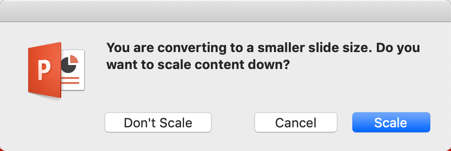
If you choose to scale it down, PowerPoint will try to fit everything as best it can into the smaller slide. If you choose Don’t Scale , the items that are outside the standard size will simply be out of the window. You’ll then have to decide whether to delete those items or move them back into the slide.
Change Slide Size in PowerPoint
Once you know what size will be ideal for your output device, you can adjust the slide size in PowerPoint.
First, go ahead and open PowerPoint and select a slide.

This guide works will work for most modern versions of PowerPoint that have the ribbon interface, including the version in Office 365.
Next, go to the Design tab. It’s where you can find the options that let you tweak your presentation’s design.

There, head over to the far right end — to where you can find the Customize section. Next, choose Slide Size .

Clicking on this option will reveal a menu. It lets you pick the size of the slide that you want. Your choices are Standard , Widescreen , and Custom Slide Size .
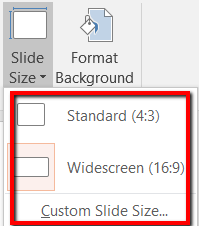
Let’s walk through each of the choices. This way, you will have a better understanding of your options. This will also help you adjust your slide’s size as needed – a size that works best for your projector or TV.
If you go with the Standard size, you’ll be going with a 4:3 aspect ratio. This is a safe choice because it works for familiar devices such as older screens with low resolutions.
A Standard slide size is a suggested choice for old school presenters. This means those who will be working with old projectors and SlideShare or other old online presentation platforms .

If you choose Widescreen , you’ll be going with an aspect ratio of 16:9. This is the ideal choice for you if you’re dealing with newer devices and online presentation platforms.
Got a Microsoft Surface device or HD projector? Going with a Widescreen option is the better way to go. The same is true if you’ll be presenting on a HDTV or 4K TV/monitor.
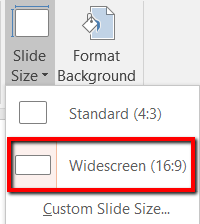
If Standard and Widescreen slide sizes are not for you, you can also go with the Custom Slide Size…
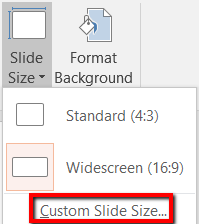
If you select this option, a pop-up window will appear.
Here, you can select from plenty of choices regarding the slide size you want. If you’re about to deliver your Powerpoint presentation on an unfamiliar projector, it’s good to go with this option.
It’s flexible. It can also accommodate your preferred slide dimensions.
Plus this way, you can select the Orientation for your slides and notes. This lets you have control over the Width and Height of your slides, too.
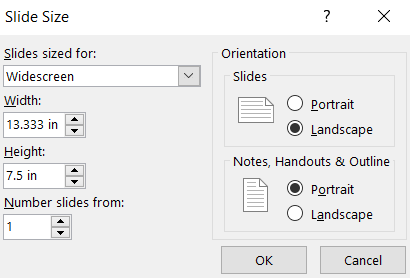
You can also try expanding the Slides sized for menu option. Doing so reveals preset sizes that go beyond the Standard and Widescreen size options.
As you can see, this option allows you to adjust your slide to fit the size of a Letter Paper, 35mm slide, a banner, 16:10 aspect ratio and more.
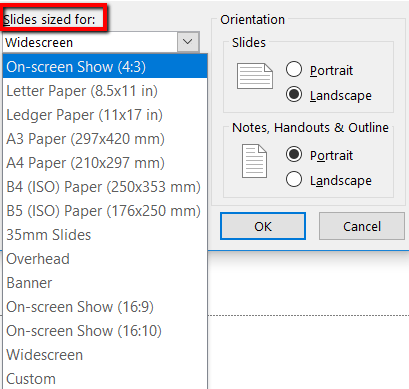
Christopher Jan Benitez is a freelance writer for hire who provides actionable and useful web content to small businesses and startups. In his spare time, he religiously watches professional wrestling and finds solace in listening to '80s speed metal. Read Christopher's Full Bio
Read More Posts:

Leave a Reply
Your email address will not be published. Required fields are marked *

How to Change Slide Size or Dimensions in PowerPoint
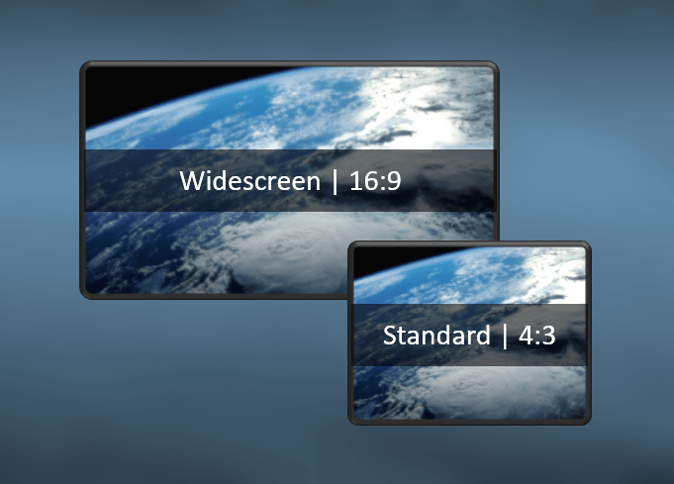
Change PowerPoint Slide Size (Widescreen, Standard or Custom)
by Avantix Learning Team | Updated September 7, 2023
Applies to: Microsoft ® PowerPoint ® 2016, 2019, 2021 and 365 (Windows)
You can change the slide size or aspect ratio of a PowerPoint presentation in all versions. The default slide size or dimensions in 2013, 2016, 2019, 2021 or 365 is widescreen (16:9 aspect ratio). You can also enter a custom slide size if you prefer (including entering slide size in pixels). The best time to set slide size is when you first set up your PowerPoint presentation before you add any content. If you change the size later in the process, you may have to deal with distorted pictures and you may also need to adjust the position and size of various objects on slides in Normal View and in the slide master(s) and layouts in Slide Master View.
The most common slide sizes or aspect ratios are typically used as follows:
- Widescreen or 16:9 aspect ratio is frequently used for onscreen presentations using a projector, monitor or a widescreen TV. Older projectors used the standard aspect ratio but most new projectors are designed for widescreen.
- Standard or 4:3 aspect ratio is often used if slides are intended to be printed on letter size paper.
Slide size changes affect the entire presentation. You cannot change slide size for single slides.
You should never change slide size just before running a presentation as you may not be satisfied with the results. If you already have a presentation with images and other content, it's also a good idea to change slide size on a copy of the presentation so you can keep the original deck and slide size.
Note: Some Ribbon tabs may appear with slightly different names if you are working with PowerPoint 365 and have a smaller screen or different display settings. Buttons on the Ribbon may appear as icons only and are also affected by screen size and display settings.
Recommended article: How to Reduce the Size of PowerPoint Presentations (10 Ways to Compress Your PowerPoint Decks)
Do you want to learn more about PowerPoint? Check out our virtual classroom or live classroom PowerPoint courses >
Regardless of the version of PowerPoint you use, you should go through your slides after you change slide size to be sure you are satisfied with the results. Be sure to check the slide master(s) and layouts in Slide Master View as well.
Change slide size to widescreen or standard
To change slide size to widescreen or standard size:
- In Normal View, click the Design tab in the Ribbon.
- Click Slide Size in the Customize group. A drop-down menu appears.
- Select Widescreen, Standard or another option from the drop-down menu. A dialog box appears with options to maximize content or scale to fit (this dialog appears only if you are moving from a larger to a smaller slide size).
- Select the desired option.
Slide Size appears on the Design tab in the Ribbon:
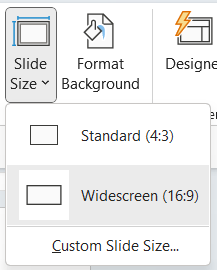
The following dialog box appears in PowerPoint to maximize content or scale to fit only when you change slide size to a smaller size (such as widescreen to standard):

If you select Maximize, the slide content will not be resized when you change to the smaller slide size.
If you select Ensure Fit, PowerPoint will scale your content to fit the smaller slide size.
Change slide size to a custom size
You can use custom slide sizes. Simply choose options from the Slides sized for drop-down menu in the dialog box (such as A4 paper size) or enter custom dimensions.
To change slide size to a custom size:
- Choose Custom Slide Size from the drop-down menu. A dialog box appears.
- Select an option from the Slides sized for drop-down menu or enter the desired slide size in the Height and Width boxes.
- A dialog box appears with options to maximize content or scale to fit (this dialog appears only if you are moving from a larger to a smaller slide size).
Note that the measurement system in PowerPoint dialog boxes is based on your system settings. If you would like to change the measurement system, check out our article on How to Change the Measurement System in PowerPoint.
The following dialog box appears when you select Slide Size and then Custom Slide Size:
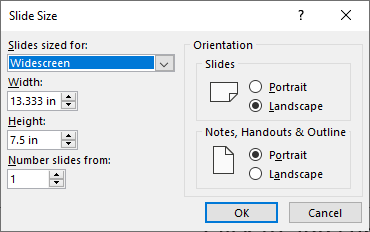
You can create posters in PowerPoint by entering a custom slide size such as 36 inches wide by 56 inches high or 91.44 cm wide by 142.24 cm high. The maximum slide size in PowerPoint is 56 inches or 142.24 cm. As a best practice, set the slide size before adding content to the poster.
Many PowerPoint users are not aware that you can enter slide size in pixels (simply enter the measurement with px beside the number). This is useful in a number of situations such as using PowerPoint to create social media posts. If you enter slide size in pixels (such as 200px), when you tab to another box or close the dialog box, PowerPoint changes the pixels to the equivalent in the current measurement system.
Deal with issues when changing slide size
When changing slide size in existing presentations with content, 4 common issues occur:
- Pictures may be distorted as PowerPoint tries to adjust images to fit slide size. Images on slides in Normal View will be affected as well as images on the slide master(s) and layouts. If pictures are distorted, you will need to either manually resize each image or delete them and insert them again.
- Objects such as placeholders and shapes that have been created in PowerPoint are not in the position you'd like. You may need to move objects or reset one or more slides (on the Home tab in the Ribbon, click Reset in the Slides group).
- Extra space is created if you change to a larger slide size. You may need to move or resize objects and adjust the slide master(s) or layouts in Slide Master View.
- If you have changed to a smaller slide size, you may need to increase font size for placeholders and text boxes.
Dimension differences between different slide sizes
In PowerPoint 2013 and later versions, widescreen (16:9) format measurements are different and are set to 13.33 inches wide by 7.5 inches high or 33.867 cm wide by 19.05 cm high. This matches the height of the 4:3 format.
Avoid issues when changing slide size
To avoid issues in PowerPoint related to slide size, you should:
- Try to set slide size as a first step after you create a presentation and before you have entered any content. In 2013 and later versions, the default is widescreen (16:9 aspect ratio).
- If you have changed slide size in a presentation with content, review your slides to be sure you are satisfied with the results. You should also check the slide master(s) and layouts in Slide Master View.
- Never change slide size just before running a presentation as you may not be pleased with the results and you won't have time to fix your slide deck.
- If you have created a presentation with content, make a copy of the presentation first and change slide size on the copy.
Keep in mind that widescreen is normally used for on screen presentations and standard is often used for printed presentations.
This article was first published on October 6, 2019 and has been updated for clarity and content.

Subscribe to get more articles like this one
Did you find this article helpful? If you would like to receive new articles, JOIN our email list.
More resources
How to Blur Text on a PowerPoint Slide
How to Get Slide Design Ideas Using PowerPoint Designer
How to Change Picture Brightness or Contrast in PowerPoint
How to Insert Slide Numbers in PowerPoint Presentations (Step-by-Step)
Where to Find Free Images for Your PowerPoint Presentations (10 Great Stock Photo Sites)
Related courses
Microsoft PowerPoint: Intermediate / Advanced
Microsoft PowerPoint: Design for Non-Designers
Microsoft PowerPoint: Animations Bootcamp
Microsoft Excel: Intermediate / Advanced
VIEW MORE COURSES >
Our instructor-led courses are delivered in virtual classroom format or at our downtown Toronto location at 18 King Street East, Suite 1400, Toronto, Ontario, Canada (some in-person classroom courses may also be delivered at an alternate downtown Toronto location). Contact us at [email protected] if you'd like to arrange custom instructor-led virtual classroom or onsite training on a date that's convenient for you.
Copyright 2024 Avantix ® Learning
You may also like

10 Keyboard Shortcuts in PowerPoint's Outline View
The outline has been an integral part of Microsoft PowerPoint for many years. It is dynamically linked to slide placeholders and is organized in a hierarchical way.

How to Change the Thumbnail for a Video in PowerPoint (using the Poster Frame Tool)
If you have inserted a video on a PowerPoint slide, you can display a custom thumbnail (or Poster Frame) for the video during a slide show. The thumbnail will display when you run a PowerPoint slide show and disappears when you start the video. For most videos, the thumbnail that displays is the first frame of the video clip. You can use the Poster Frame command to display a different frame in the video clip or a picture from another source as a thumbnail. A picture thumbnail could be either an image or an icon.

How to Use the Built-in Laser Pointer in PowerPoint (with Shortcuts)
During a PowerPoint slide show, you can change your mouse into a laser pointer to focus attention on a specific area on your slide. You can show or hide the built-in laser pointer using keyboard shortcuts or by using the context menu.
Microsoft, the Microsoft logo, Microsoft Office and related Microsoft applications and logos are registered trademarks of Microsoft Corporation in Canada, US and other countries. All other trademarks are the property of the registered owners.
Avantix Learning |18 King Street East, Suite 1400, Toronto, Ontario, Canada M5C 1C4 | Contact us at [email protected]

Our Courses
Avantix Learning courses are offered online in virtual classroom format or as in-person classroom training. Our hands-on, instructor-led courses are available both as public scheduled courses or on demand as a custom training solution.
All Avantix Learning courses include a comprehensive course manual including tips, tricks and shortcuts as well as sample and exercise files.
VIEW COURSES >
Contact us at [email protected] for more information about any of our courses or to arrange custom training.
Privacy Overview
Pin it on pinterest.
- Print Friendly
How to change the size of slides in Microsoft PowerPoint to match your customized presentation style or screen size
- You can change the size of a slide in your PowerPoint presentation through the "Design" menu.
- Microsoft PowerPoint allows you to change slide sizes on the Windows PC, Apple MacOS, and web-based apps.
- Visit Business Insider's Tech Reference library for more stories .
When it comes to designing your visual presentation, one size does not fit all.
That's doubly true for PowerPoint presentations, which may be viewed on several platforms and devices. Sometimes PowerPoint's default slide isn't the best option for your project, and the program has a built-in fix for that.
When you create a presentation in Microsoft PowerPoint, you can customize your slides' size and dimension. This allows you to choose a perfect canvass for your content.
Microsoft offers the ability to change the size of your slides on the Windows, Mac, and web-based apps. Here's how to do it.
Check out the products mentioned in this article:
Microsoft office (from $149.99 at best buy), apple macbook pro (from $1,299.00 at apple), acer chromebook 15 (from $179.99 at walmart), how to change slide size in powerpoint for pc.
1. Open an existing PowerPoint file, or start a new presentation.
2. Select "Design" from the top menu bar.
3. Toward the right, click "Slide Size."
4. In the drop-down menu, select Standard, Widescreen, or "Custom Slide Size…"
5. When you're done, click "OK."
How to change slide size in PowerPoint for Mac
1. Create a new presentation, or launch an existing file.
2. Click "Design" from the top-line row of options.
3. Toward the right, you'll see "Slide Size." Click it for a drop-down menu of options.
4. Select the included Standard or Widescreen options, or click "Page Setup…" for a custom size.
5. Choose "OK" when you're done.
How to change slide size in PowerPoint for web
1. Navigate to powerpoint.office.com and sign in to your Microsoft account.
2. Open a new or existing PowerPoint.
3. Select "Design" from the top row of options.
4. Click "Slide Size."
5. Select between Widescreen and Standard, or create custom dimensions with "Custom Slide Size…"
6. If selecting custom, enter the dimensions and then choose whether you want it in landscape or portrait mode.
7. Choose between maximizing your slide size or scaling it to fit the new dimensions.
8. Click "OK."
Related coverage from Tech Reference :
How to download and access microsoft powerpoint on your mac computer, how to add a border to slides in powerpoint, and give your slideshow a sleek design, how to change and format the background of your powerpoint slides to custom designs, how to change your language settings in microsoft powerpoint in 3 different ways, how to copy or duplicate a powerpoint slide and put it anywhere in your slideshow.
Insider Inc. receives a commission when you buy through our links.
Watch: We toured a $7 million NYC apartment that has a slide and zip line, and it's a kid's paradise
- Main content
How to change the size of slides in Microsoft PowerPoint
The actual size(s) of the slide is less important than the aspect ratio. By default, slides in presentations that you create from the Blank Presentation template are set to Widescreen size.
To change the size of your presentation slides, on the Design tab, in the Customize group, click the Slide Size button and then:
Notes : The Standard slide size:
- 1600 x 1200
- 2048 x 1536
- 2560 x 1920
- Matches the aspect ratio of standard tablet screens
- Exactly fills the screen in the Slide pane and when printed on a tablet.
Notes : The Widescreen slide size:
- 1920 x 1080
- 2048 x 1152
- 2560 x 1440
- Does not match the aspect ratio of standard tablet screens
- Has empty space above and below when printed on a 4:3 screen.
- Click Custom Slide Size... :

In the Slide Size dialog box:

- Choose the slide orientation in the Orientation group.
After choosing the necessary options, click OK . The Microsoft PowerPoint dialog box will show two options on how to scale the existing slides to a new slide size:

Maximize the content size or scale it down to Ensure Fit it on the new slide.
Note : It is impossible to change the size or orientation just for some slides.
Please, disable AdBlock and reload the page to continue
Today, 30% of our visitors use Ad-Block to block ads.We understand your pain with ads, but without ads, we won't be able to provide you with free content soon. If you need our content for work or study, please support our efforts and disable AdBlock for our site. As you will see, we have a lot of helpful information to share.

How to compress pictures in the presentation

SketchBubble Review - Engaging Presentations at Your Fingertips

Embed fonts to view presentation on different PCs

How to Change Paper Size in PowerPoint
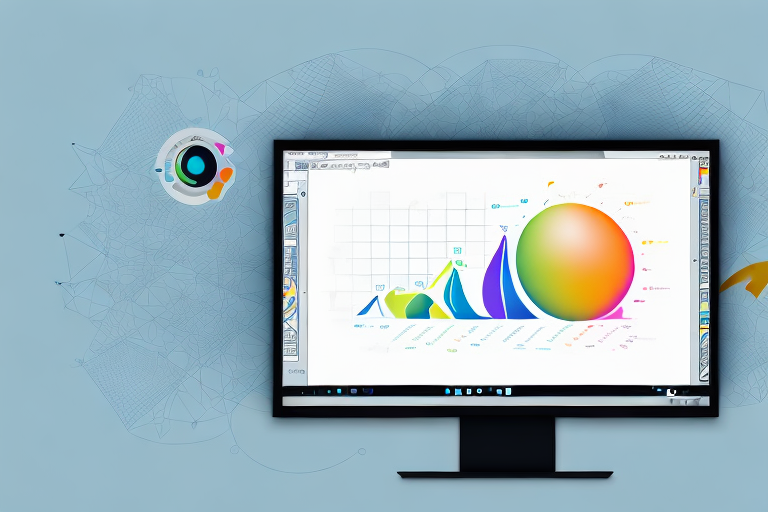
PowerPoint is a powerful tool used by millions of people across the globe to create professional presentations. One of the critical aspects of creating an effective presentation is choosing the right paper size. By default, PowerPoint comes with the standard 8.5 x 11 inches paper size. However, in many instances, this might not be sufficient, and you may need to change the paper size. In this article, we will explore the different aspects of changing paper size in PowerPoint and provide you with a comprehensive guide to do so successfully.
Table of Contents
Understanding the Need for Changing Paper Size in PowerPoint
Changing the paper size in PowerPoint may seem trivial, but it can determine how visually appealing, professional, and effective your presentation looks. Choosing the right paper size ensures that your presentation looks sharp, clear, and well-structured. Depending on the type of presentation, the audience, and the display devices, you may need to change the paper size. For instance, if you are presenting on a widescreen projector, you may need to choose a widescreen paper size to ensure your presentation fills the screen entirely.
Another reason why changing paper size in PowerPoint is important is to ensure that your presentation is optimized for printing. If you plan to print your presentation, you need to choose a paper size that matches the printer’s paper size. This ensures that your presentation prints correctly and looks professional. Additionally, changing paper size can also help you to create handouts that are easy to read and follow. By choosing a paper size that is appropriate for handouts, you can ensure that your audience can easily follow along with your presentation.
It is also worth noting that changing paper size in PowerPoint can help you to create presentations that are accessible to people with disabilities. For example, if you are creating a presentation that will be viewed by people with visual impairments, you may need to choose a larger paper size to ensure that the text and images are clear and easy to read. Similarly, if you are creating a presentation that will be viewed by people with hearing impairments, you may need to choose a paper size that allows you to include captions or subtitles for your audio content.
Different Paper Sizes Supported by PowerPoint
PowerPoint supports a range of paper sizes suitable for various purposes. The standard paper size is the 8.5 x 11 inches, but PowerPoint also supports other paper sizes such as 11 x 17 inches, A3, A4, B4, B5, and many more. Choosing the right paper size depends on various factors such as the content, audience, and display devices. Therefore, it’s essential to understand the different paper sizes supported by PowerPoint to make an informed decision.
When selecting a paper size for your PowerPoint presentation, it’s important to consider the aspect ratio of your slides. The aspect ratio is the proportional relationship between the width and height of your slides. The standard aspect ratio for PowerPoint is 4:3, but there are also widescreen options such as 16:9 and 16:10. Choosing the correct aspect ratio for your presentation can ensure that your slides look their best and are optimized for the display device.
Steps to Change the Paper Size in PowerPoint 2016 and Later Versions
Changing the paper size in PowerPoint 2016 and later versions is relatively easy. Here are the steps:
- Open your PowerPoint presentation.
- Click on the Design tab.
- Click on the Slide Size button in the Customize group.
- Select your desired paper size from the list or choose Custom Slide Size to set a custom paper size.
- Click on OK, and your slide size will change to the selected size.
It is important to note that changing the paper size may affect the layout of your slides. You may need to adjust the size and position of your text boxes, images, and other elements to ensure they fit properly on the new paper size.
Additionally, if you plan to print your presentation, make sure your printer supports the selected paper size. Otherwise, you may need to adjust the paper size in your printer settings or choose a different paper size that is supported by your printer.
How to Change the Paper Size in Earlier Versions of PowerPoint
If you are using an earlier version of PowerPoint such as 2013, 2010, or 2007, the steps to change the paper size are slightly different. Follow these steps:
- Click on the Page Setup button in the Page Setup group.
- Select your desired paper size from the list or choose Custom to set a custom paper size.
It is important to note that changing the paper size in earlier versions of PowerPoint may affect the layout of your slides. You may need to adjust the size and position of your text boxes, images, and other elements to ensure they fit properly on the new paper size. It is recommended to preview your presentation before printing or presenting to ensure everything looks as intended.
Tips for Choosing the Right Paper Size for Your Presentation
Choosing the right paper size for your presentation is essential to ensure its effectiveness. Here are some tips to help you choose the right paper size:
- Consider the display devices: Choose a paper size that matches the aspect ratio of the display devices to ensure that it fills the screen entirely, thereby reducing the chances of pixelation.
- Think about the audience: Consider the preferences, needs, and expectations of your audience before choosing a paper size. A larger size may be more effective if you are presenting to a large audience in a large venue.
- Test before presenting: Always test your presentation on different devices and venues to ensure that the chosen paper size is compatible with all the devices your audience might be using, and it looks consistent and professional.
Another important factor to consider when choosing the right paper size for your presentation is the amount of content you have. If you have a lot of information to present, a larger paper size may be more appropriate to ensure that the text and images are clear and easy to read. On the other hand, if you have less content, a smaller paper size may be more suitable to avoid overwhelming your audience with too much information.
Common Issues Faced While Changing the Paper Size in PowerPoint and How to Fix Them
Changing the paper size in PowerPoint may not always be smooth, and you may encounter some issues. Here are some common ones and how to fix them:
- Text and images may not adjust to the new size: In some instances, text and images may get cut off or distorted while changing paper size. To fix this, select the slides and apply the Autofit feature to adjust the text and images to fit the new size.
- Aspect ratio may get distorted: Changing the paper size may affect the aspect ratio, leading to distorted pictures and videos. To fix this, select the picture or video, click on the Picture Format or Video Format tab, and select the option that retains the aspect ratio.
Another common issue that may arise while changing the paper size in PowerPoint is that the layout of the slides may get disrupted. This can happen when the new paper size is significantly different from the original one. To fix this, you can try adjusting the layout manually by moving the elements around or using the Slide Master feature to make global changes to the layout.
Additionally, changing the paper size may also affect the font size and style of the text on the slides. This can make the presentation look inconsistent and unprofessional. To avoid this, it is recommended to use a standard font size and style throughout the presentation. You can also use the Replace Font feature to quickly change the font style and size of all the text on the slides.
How to Ensure Compatibility of the Changed Paper Size Across Devices
It’s crucial to ensure the compatibility of the changed paper size across devices, as not all devices may support the same paper size. Here are some steps to ensure compatibility:
- Test on multiple devices: Test your presentation on multiple devices to ensure that the chosen paper size is compatible with all of them.
- Save as PDF: To ensure that the presentation retains its formatting, save it as a PDF file so that the paper size is consistent across all devices.
Another important step to ensure compatibility is to check the printer settings before printing. Make sure that the printer is set to the correct paper size and orientation to avoid any issues with the printed document. Additionally, it’s important to communicate the paper size changes to any collaborators or recipients of the document to avoid confusion or formatting issues.
Advantages of Changing Paper Size for Your PowerPoint Presentation
Changing the paper size in PowerPoint can have numerous advantages, such as:
- Improving the visual appeal: Choosing the right paper size can enhance the overall look of your presentation, make it more visually appealing, and improve its professional appearance.
- Optimizing for different devices: Different devices have different screen sizes and display ratios. Changing paper size can optimize your presentation to fit perfectly on all devices, help reach a broader audience, and improve the user experience.
Another advantage of changing paper size for your PowerPoint presentation is that it can help you save printing costs. By choosing a smaller paper size, you can fit more slides on a single page, reducing the number of pages you need to print. This can save you money on paper, ink, and printing services.
Additionally, changing paper size can also help you create more engaging handouts for your audience. By choosing a larger paper size, you can include more detailed information, graphics, and images on your handouts, making them more informative and useful for your audience. This can also help your audience remember your presentation better and refer back to it later.
Best Practices for Changing Paper Size in PowerPoint to Enhance Your Presentation’s Effectiveness
Here are some best practices to follow when changing paper size in PowerPoint:
- Stick to standard sizes unless needed: Unless required, stick to the standard 8.5 x 11 inches paper size, as it is supported by most devices and is a safe choice.
- Consider the audience and venue: Choose a paper size that is suitable for your audience, venue, and display devices.
- Test, test, test: Always test your presentation on different devices, venues, and screen resolutions, so that you can ensure that the chosen paper size is compatible and effective across all.
Changing the paper size in PowerPoint can drastically enhance the effectiveness, professionalism, and visual appeal of your presentation. By following the steps and tips outlined above and implementing best practices, you can effectively change the paper size and optimize it for different devices and venues. Always remember to test your presentation across multiple devices and resolutions to ensure that it looks consistent, professional, and effective across all platforms.
By humans, for humans - Best rated articles:
Excel report templates: build better reports faster, top 9 power bi dashboard examples, excel waterfall charts: how to create one that doesn't suck, beyond ai - discover our handpicked bi resources.
Explore Zebra BI's expert-selected resources combining technology and insight for practical, in-depth BI strategies.

We’ve been experimenting with AI-generated content, and sometimes it gets carried away. Give us a feedback and help us learn and improve! 🤍
Note: This is an experimental AI-generated article. Your help is welcome. Share your feedback with us and help us improve.

How to change slide size in PowerPoint
- Written by: Harriet Jones
- Categories: PowerPoint design

Why would anyone want to change the slide size in PowerPoint? You open a file, it’s the perfect 16:9 (no 4:3 fans here!), and you get stuck in, right? Well, it depends what you’re using PowerPoint for…
Presentations are a powerful tool for communicating with your audience. But if you’re making presentations, the chances are you’re also looking for other ways to get your message out there. Perhaps you want to share news on your social media feeds, present a poster at a conference, have downloadable brochures on your website, or create business cards to hand out to unsuspecting members of the public.
You might be thinking, that sounds great, but I don’t have the tools to do all that! Would you believe me if I told you can do all this and more in good-old-PowerPoint?
PowerPoint is easy-to-use, quick to edit, and is super versatile. The feature that makes creating all these different materials possible is the ability to change the size of PowerPoint slides to your desired dimensions. ‘But how?’ I hear you cry. Well, cry no more! In this blog post I’ll teach you how to change slide size in PowerPoint.
If you’re a Google Slides user who’s wandered into the wrong blog post – this one on changing slide size in Google Slides might be what you’re looking for.
Quick guide:
- In the Design tab choose Slide Size . The highlighted box shows the current dimensions of your slides.
- In the Slide Size drop down, select Custom Slide Size .
- Select the slide size you want to use.
Step-by-step:
To know what to change, you need to know where you’re starting. When you open a brand new PowerPoint file, the standard slide dimension is widescreen (16:9). This is ideal for presentations because it matches the size and proportions of most modern screens.
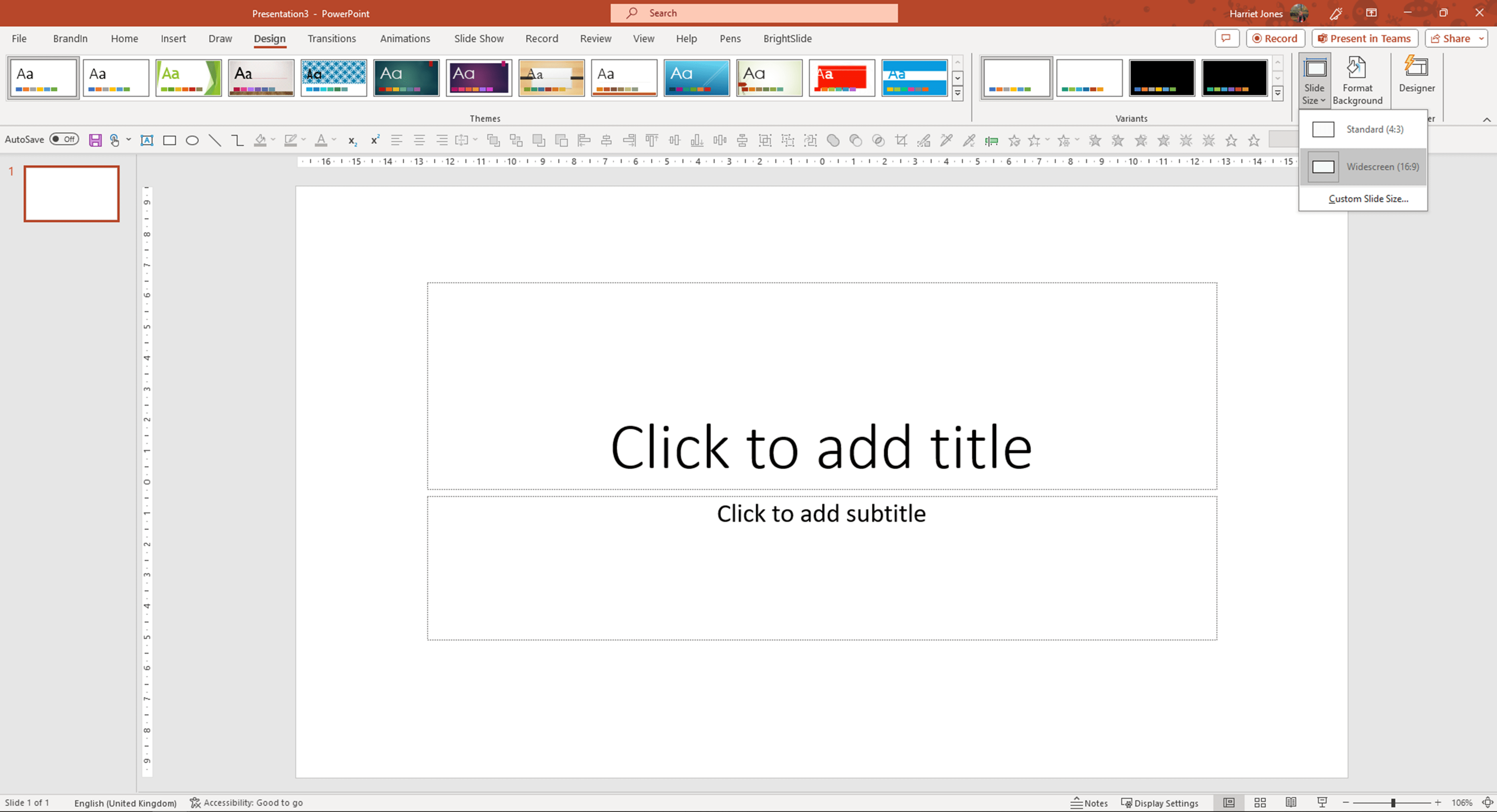
To check your slide dimensions head to the Design tab then choose Slide Size . The highlighted box shows you the current dimensions of your slides.
To change your slide size, under the Slide Size drop down, select Custom Slide Size .
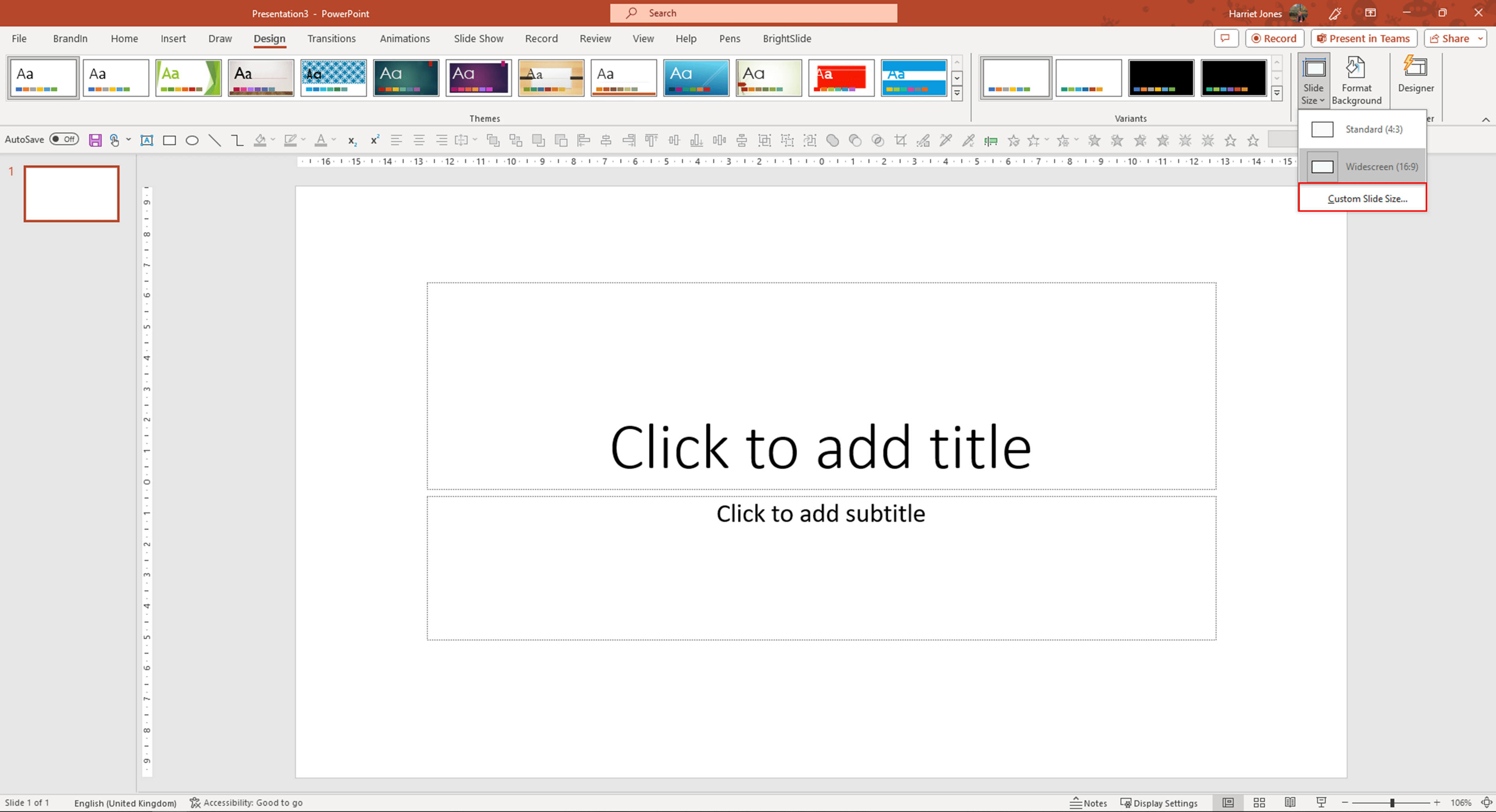
A pop-up box appears, and you can customise the slide size to suit your needs.
What’s helpful is that PowerPoint already has options built in for standard formats, such as Letter paper and A4, so you don’t have to spend time searching the web for the dimensions you need.

Not every combination of width and height is available in this drop down (including the dimensions for popular social media sites). So if you need a truly custom slide size, you can directly input your measurements. Select Custom from the drop-down list and type in the Width and Height you need.
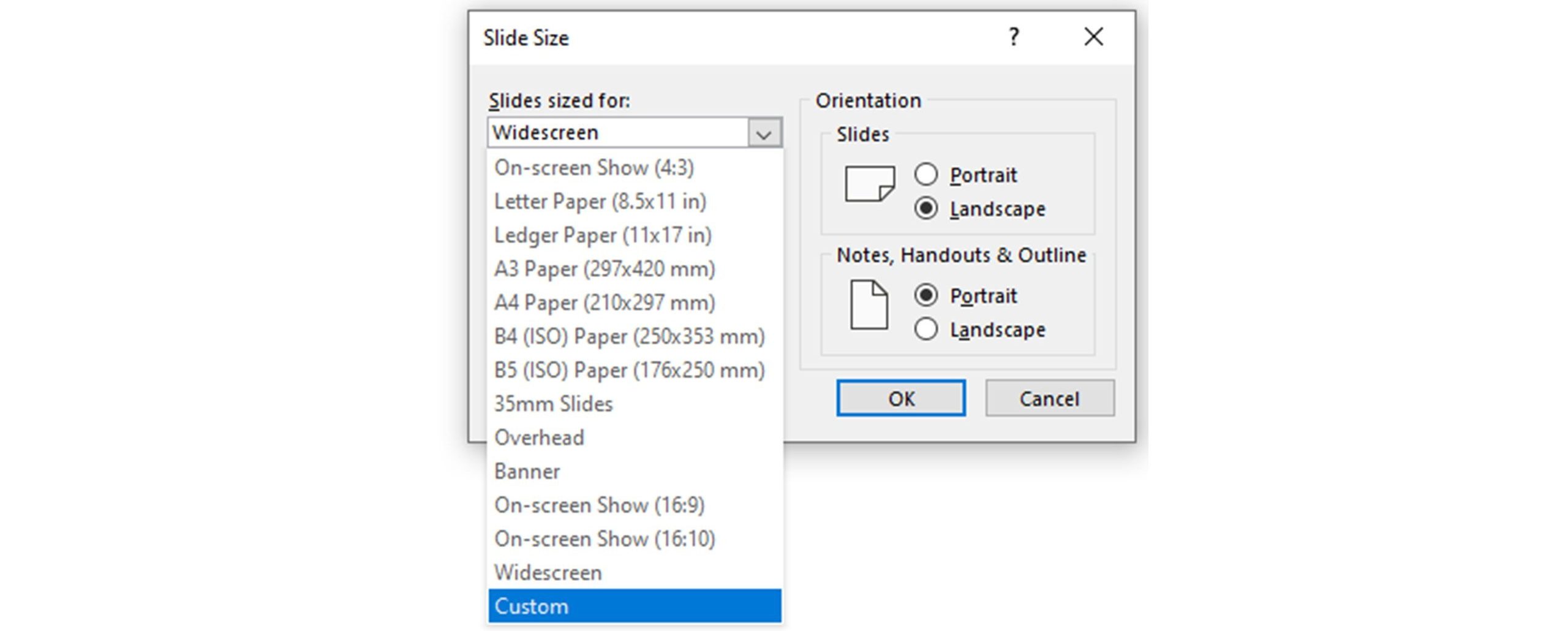
PowerPoint will ask you if you want to ensure fit or maximize fit. Typically you would choose to maximise when increasing the size of your slides, and ensure fit when decreasing slide size.
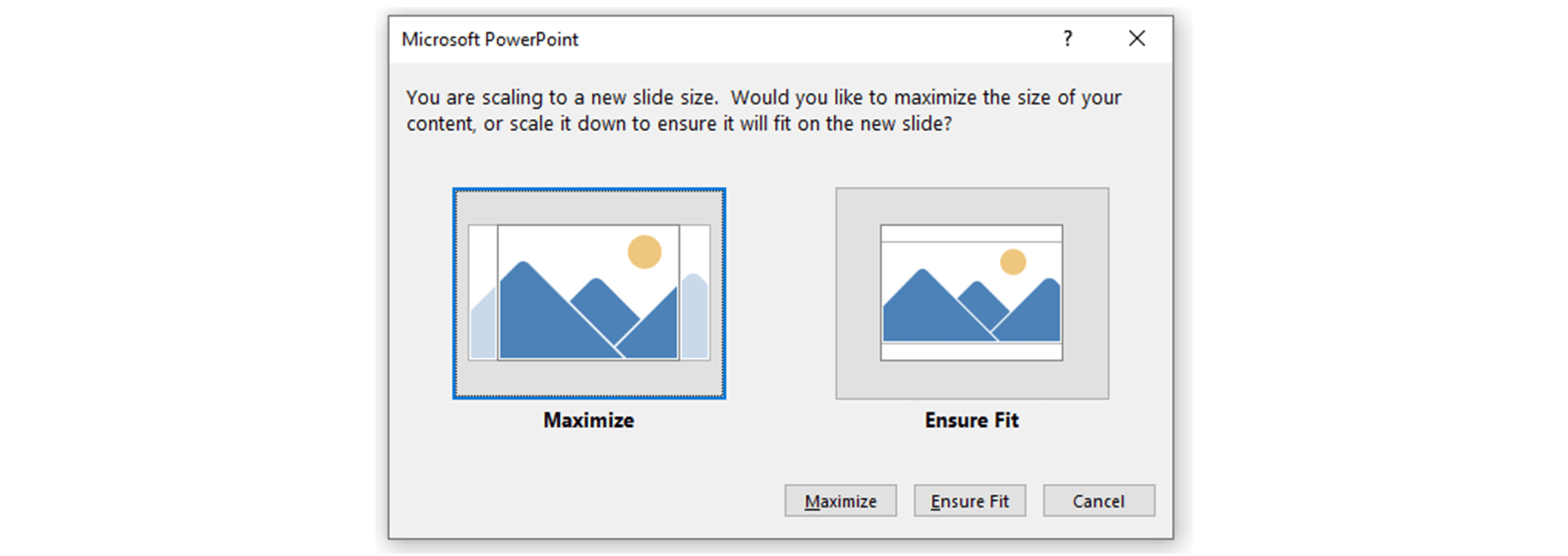
Maximise will increase the size of any existing content on the slide, but as a result, all the content might not fit on the slide. Ensure fit scales down the size of existing content making it appear smaller but ensuring all the content fits on the slide. This is why it’s best to set the slide size right at the beginning and then you don’t need to worry about this.
After you’ve made your selection, select OK , and hey presto, you’ve done it.
For this example, we’ve chosen the size of a regular square Instagram post.

Converting aspect ratio to dimensions
Just a side note on working out what slide size you need for creating social media posts. When you look up dimensions for an Instagram post, the most popular Google results tell us it’s 1080px by 1080px, but as you can see in the screenshots above, it looks like PowerPoint wants us to input our dimensions as cm. This can be a little confusing, especially for us non-designers out there who don’t know our pixels (px) from our points (pts). There are lots of websites online that can help you convert your measurements, like here – www.unitconverters.net . However, it’s a little know fact that you can enter dimensions in cm, inches or pixels and PowerPoint will convert it for you! Just type the numbers, then a space and then the unit abbreviations (cm, in, px). For a comprehensive guide on all social media image sizes check out this article by Brandwatch .
A regular Instagram post is a square, so that’s easy as the ratio is 1:1, meaning the width is the same as the height. With rectangles, the ratio of width to height will differ. A LinkedIn post for example, can either be portrait 1080 x 1350 or landscape view at 1280 x 720. So for the portrait the ratio is 4:5 and landscape is approximately 16:9. Don’t let this intimidate you. If you divide both sides (width and height) by the same amount you guarantee the ratio will stay the same.
If you’re entering slide size details as centimetres make sure you consider the overall slide size in cm as this will affect the size of an image export, which in turn can affect the quality of your exported image. Put simply an Instagram post made on a 2cm by 2cm slide will be poorer quality than one made on a 10cm by 10cm one. We have a helpful blog post that goes into much more detail on Picture size and resolution in PowerPoint .
Now that you’re a pro on how to change PowerPoint slide size, let’s go through some examples of the awesome things you can do with this new knowledge. But before we do that just a note – there are dedicated software to create a bunch of the things we’ve mentioned in this article. If you have access to it, that’s amazing! Use it! But for many of us, PowerPoint is one of our only design tools and purchasing a handful of other programs isn’t on the cards, so we need to get the most out of PowerPoint that we can.
Academic posters
For researchers and students alike, creating academic posters can be one of the more gruelling tasks on your to-do list. For most people that’s because they struggle to make posters look beautiful and engaging meaning people miss out on reading your incredible work! With your new knowledge of how to change slide size in PowerPoint, you can start making A4 and A3 posters in PowerPoint.
Some things to remember…
A poster should never be an impenetrable wall of text but a visual summary of your work. It should be concise with plenty of white space, accessible, with a clear and logical layout. A great poster is a conversation starter that drives the audience to learn more.

We have a whole blog post on to how to create beautiful and effective academic posters in PowerPoint , so make sure you give that a read for more tips and tricks and a couple of cheeky freebies!
Social media posts
Once you know how to change slide size in PowerPoint you can create graphics for all your social media channels. Whether it’s for Instagram, LinkedIn, Facebook or Twitter… sorry X, we’ve got you covered. Check out this blog post on how to create social media posts in PowerPoint , from colours to image manipulation to animation! In the rapidly changing world of social media, you need to strike a balance between compelling visuals and concise messaging, to get your audience to stop scrolling, pay attention and remember your message.

If you have mind-blowing stats to share, but struggle with data visualisation, spend a little time working on your data vis skills before getting started. Start here .
And, thanks to the wonders of PowerPoint animation, you’re not just limited to static social media materials when creating in PowerPoint. Dynamic GIFs are a cool way to captivate your audience and are easier to make than you might think. When creating your GIF, remember to keep it short to capture and keep attention, and focus on smooth transitions for a polished, professional result.
Honourable mentions
Here’s a few more handy blog posts to check out for extra tips and tricks on creating anything BUT presentations in PowerPoint!
How to get the most out of PowerPoint and PDFs
How to make an infographic in PowerPoint
How to make a PowerPoint memory game
You’ve made it – now you know how to change slide size in PowerPoint and hopefully are inspired to use PowerPoint to create more than just presentations.

Harriet Jones
Communication consultant, related articles, insights from a presentation templates expert.
- PowerPoint design / Industry insights
A PowerPoint template is the foundation on which polished and professional presentations are built. We interview BrightCarbon’s new Templates Lead, Gemma Leamy, and pick her brains on the ideal process for creating robust PowerPoint templates.

115 PowerPoint Christmas cards to download and share!
- PowerPoint design
- Comments: 45
It's Christmas! After a late night with too much eggnog and brandy snaps we set ourselves a challenge to see who could come up with the wildest PowerPoint Christmas card! So it's the day after the night before, and through blurry eyes we can reveal our efforts...

How to create PowerPoint templates that work
Without a proper PowerPoint template, presentations can be a bit of a mess. Here are the building blocks for developing a PowerPoint template that works!

Leave a Reply Cancel reply
Save my name and email in this browser for the next time I comment.
Join the BrightCarbon mailing list for monthly invites and resources
It is, quite simply, the best deck we have. I did a nice presentation with it yesterday and would like to do the same next week... I am sure it will get a lot of use. The visual impact and flow are compelling! Peter Francis Janssen

How to Change the Slide Size in PowerPoint Presentations

Changing the slide size in PowerPoint is a great way to create custom and unique presentations. The default slide size in PowerPoint is 10 inches wide by 7.5 inches tall, but you may want a different slide dimension for things like widescreen presentations or to fit a different paper size. Fortunately, customizing the slide size in PowerPoint only takes a few clicks.
Why Change the Slide Size
Here are some common reasons you may want to use a custom slide size in PowerPoint:
- Create widescreen presentations for HD displays
- Fit the slides to a custom paper size you want to print on
- Make square slides for Instagram or Facebook posts
- Craft vertical slides for mobile displays
- Produce slides sized for digital signage screens
- Change the aspect ratio for a more cinematic look
Using non-standard slide sizes can make your presentations stand out with unique dimensions tailored to your needs.
Access the Slide Size Dialog Box
To change the slide size in PowerPoint, you first need to open the Slide Size dialog box. Here’s how:
- Open your PowerPoint presentation and click on the “Design” tab
- Click on the “Slide Size” button – it’s in the Customize group on the far right
- The Slide Size dialog box will open
This dialog box allows you to input new slide dimensions or choose from some common preset sizes.
Slide Size Dialog Box
Choose a Preset Size
The easiest way to change the slide size is to use one of PowerPoint’s preset sizes in the drop-down menu. This has common sizes like widescreen dimensions and paper sizes already configured.
For example, to create widescreen 16:9 slides, choose “Widescreen (16:9)” from the drop-down menu.
If you want letter paper sized slides, choose “Letter Paper (8.5 in. by 11 in.)” from the list.
Review all the preset sizes to see if any meet your needs. If not, you can create a custom size.
Create a Custom Slide Size
To make a completely custom slide size, use the width and height fields in the dialog box.
- Enter your desired width in inches into the width field
- Enter your desired height in inches into the height field
- Click “OK” to apply the custom size
For example, to create square 5 inch by 5 inch slides, enter 5 inches into both fields.
You can create any dimensions this way. Common custom sizes are 1920 x 1080 pixels for full HD or 1280 x 720 pixels for 720p HD.
Tip: Check the orientation icons to choose portrait or landscape slides.
Preview and Apply Slide Size
When you click OK, PowerPoint will automatically reformat your current slides to fit the new size. Depending on the difference in size, this may affect objects positioned on the slides.
It’s a good idea to scroll through your entire presentation to preview how the slides look. Zoom in and out to check alignment and positioning of images and text boxes.
If anything looks off, go back to the Design tab and click “Slide Size” again to undo or choose a different custom size.
Once you are happy with the slide dimensions, your presentation is ready with the new slide size set. For any new slides you add, they will automatically use the custom dimensions.
Adjusting Content That Doesn’t Fit
If your presentation already had content on the slides before changing the size, some elements may now appear out of position or not fit correctly.
A few things you can do:
- Resize and reposition pictures and text boxes that look off
- Change font sizes if text doesn’t fit anymore
- Adjust margins through the slide master to fit content
- Add exceptions for certain slides if one size doesn’t work for all slides
With a little tweaking, you can refine your presentation so everything looks right with the new slide size.
Adding Exceptions for Certain Slides
If you only want certain slides to have the custom size, add exceptions to override the default slide size.
To do this:
- Select the slides you want to override
- Right click and choose “Layout”
- Click “Slide Size” and choose the size just for those slides
Now you can mix and match slide sizes throughout your presentation.
Printing Slides With Custom Sizes
One final tip – if you created slides with a custom size for printing, be sure to check that your printer can handle the dimensions you chose. You may need to adjust the scale or do a test print first on a single slide to confirm the size comes out as expected on paper.
About The Author
Vegaslide staff, related posts.

How to Flip a Shape in Microsoft PowerPoint

PowerPoint 2007: Animating Text and Objects

How to Add Slide Numbers in PowerPoint

PowerPoint 2003: Formatting Bulleted and Numbered Lists


Contribute to the Microsoft 365 and Office forum! Click HERE to learn more 💡
March 14, 2024
Contribute to the Microsoft 365 and Office forum!
Click HERE to learn more 💡
Top Contributors in PowerPoint: Steve Rindsberg - Jim_ Gordon - John Korchok ✅
March 11, 2024
Top Contributors in PowerPoint:
Steve Rindsberg - Jim_ Gordon - John Korchok ✅
- Search the community and support articles
- Microsoft 365 and Office
- Search Community member
Ask a new question
Powerpoint Printing Actual Size
Report abuse, replies (5) .
- Volunteer Moderator
If your slide is in 4:3 (Standard) aspect ratio, it is normally 10"wide x 7.5" high and will print at the correct size on letter-size piece of paper with a 1/2" border.
If your slide is 16:9 Widescreen format originally created in PowerPoint 2007 or 2010, it is 10"x 5.63" and will print on letter-size paper with 1/2" margins on either side. Newer widescreen slides must be printed on legal-size paper to print at the correct size, since they are 13.33"x 7.5"
When you create your custom size (I'm guessing 11"x 8.5") you have no allowance for the printer margins, so the printer driver might be trying to fit the slide into it's printable area rather than print it at 100%. The problem is with your printer driver settings, not with PowerPoint.
17 people found this reply helpful
Was this reply helpful? Yes No
Sorry this didn't help.
Great! Thanks for your feedback.
How satisfied are you with this reply?
Thanks for your feedback, it helps us improve the site.
Thanks for your feedback.
7 people found this reply helpful
Start by choosing Design>Slide Size>Custom Slide Size and set the Slides sized for dropdown to A4 Paper (210x297 mm) . This will give you a working area of 10.833" x 7.5". Draw your art and print to A4 without scaling (100%).
27 people found this reply helpful
6 people found this reply helpful
15 people found this reply helpful
Question Info
- Norsk Bokmål
- Ελληνικά
- Русский
- עברית
- العربية
- ไทย
- 한국어
- 中文(简体)
- 中文(繁體)
- 日本語
How to Size Your Slides for Legal Paper in Powerpoint 2013
Microsoft Office products are often configured for your current geographic location. This can mean default paper sizes, or margins on your document. But much like you might need to switch between centimeters and inches for Word margins , you may need to change the size of your slides in Powerpoint.
While Microsoft Powerpoint is easier to manage when you are presenting on a screen, it can typically look fine when you need to print out a slide show. But you may be wondering how to change your paper size if you are designing a printed presentation and using a non-default paper size.
Printing on legal paper can be a little more difficult than it should be in some situations, and you may have found that one of those situations can come up with Microsoft Powerpoint. The legal paper size is often ideal for certain types of presentations, particularly if you need the extra page space when you print the presentation.
But you might be having trouble getting your presentation sized properly and, ultimately, printing it out. Our guide below will show you a few different settings to adjust so that the printed legal-sized Powerpoint presentation looks as good on paper as it does on your screen.
How to Change Paper Size in Powerpoint
- Open your slideshow.
- Select Design .
- Click Slide Size , then Custom Slide Size .
- Enter the desired dimensions, then click OK .
- Choose how to adjust existing content.
Our article continues below with additional information on changing the paper or slide size in Powerpoint, including pictures of these steps.
If you use speaker notes in Powerpoint but are having trouble with Google Slides, then our how to see speaker notes on Google Slides app tutorial can help you to find them.
How to Set the Slide Size to Legal Dimensions in Powerpoint 2013 (Guide with Pictures)
The steps in this article are going to change the dimensions of your slides to be the same dimensions as legal paper. You will then be able to adjust the print size of the presentation to print those slides, if necessary, on legal paper without any weird formatting issues that might otherwise arise.
Step 1: Open your presentation in Powerpoint 2013.
Step 2: click the design tab at the top of the window..
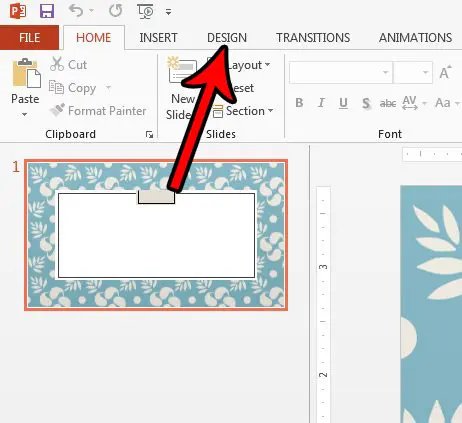
Step 3: Click the Slide Size button in the Customize section at the far right end of the ribbon, then click the Custom Slide Size option.
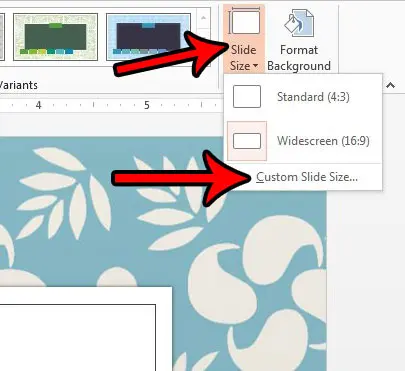
Step 4: Set the Width to 13 in and the Height to 7.5 in, then click the OK button.
The actual dimensions of legal paper are 14 inches by 8.5 inches, but you need to give a little leeway for margins.
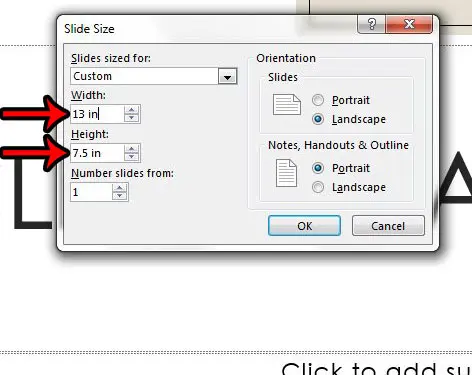
Step 5: Select the resizing option that you prefer.
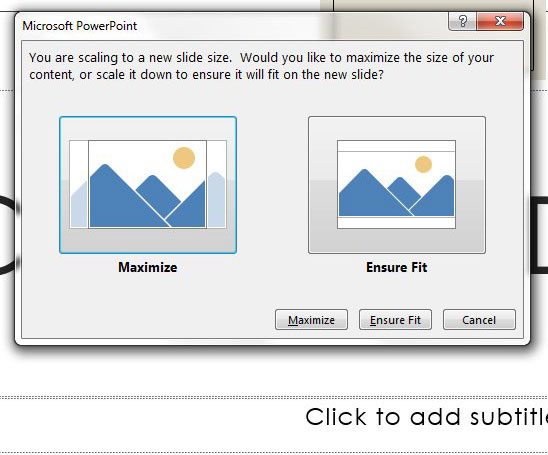
Step 6: Click the File tab at the top-left corner of the window.
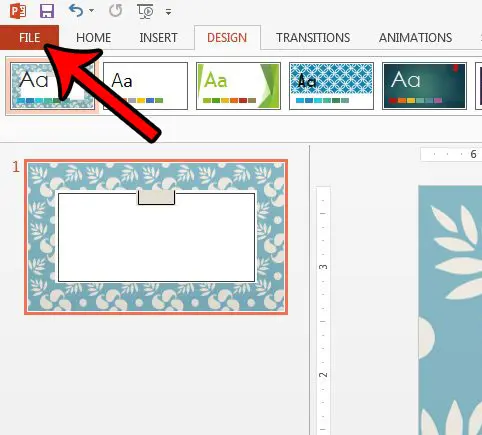
Step 7: Select the Print option.
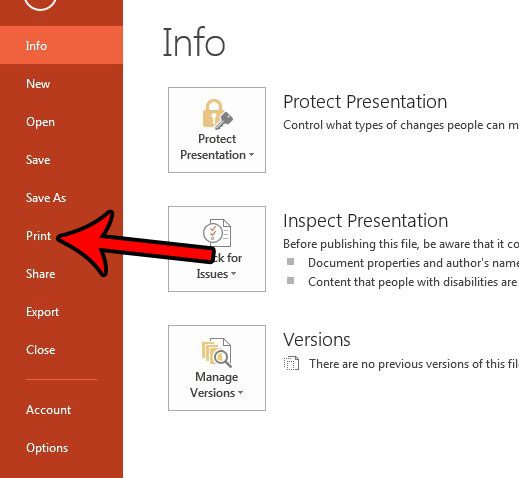
Step 8: Click the Printer Properties button and choose to print on legal paper.
This is a little different on each printer, so your options here can vary. Then click the Full Page Slides button and ensure that the Scale to Fit Paper option is selected. You can then print the presentation.
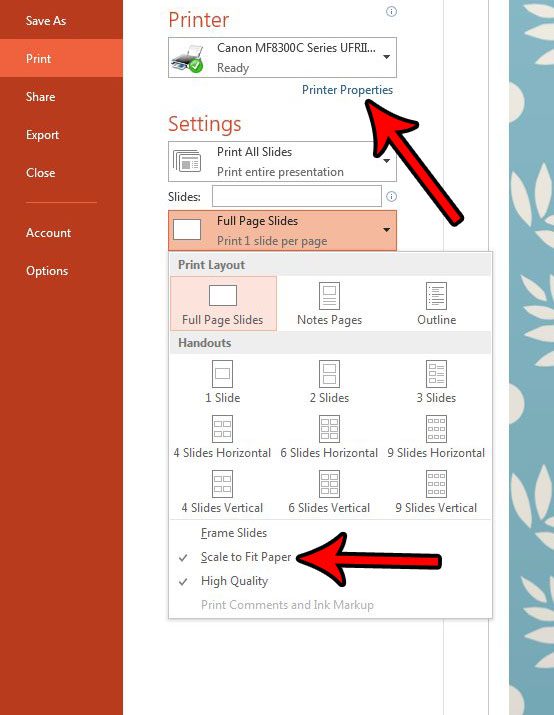
Would you also like to print the notes for your presentation so that you can use them when you are speaking? Learn how to print speaker’s notes in Powerpoint 2013 .
Additional Sources

Matthew Burleigh has been writing tech tutorials since 2008. His writing has appeared on dozens of different websites and been read over 50 million times.
After receiving his Bachelor’s and Master’s degrees in Computer Science he spent several years working in IT management for small businesses. However, he now works full time writing content online and creating websites.
His main writing topics include iPhones, Microsoft Office, Google Apps, Android, and Photoshop, but he has also written about many other tech topics as well.
Read his full bio here.
Share this:
Join our free newsletter.
Featured guides and deals
You may opt out at any time. Read our Privacy Policy
Related posts:
- How to Save Powerpoint as PDF with Notes
- How to Set Time for Slides in Powerpoint
- Can I Convert My Powerpoint to Google Slides?
- How to Unhide a Slide in Powerpoint 2013
- How to Add Page Numbers in Powerpoint 2010
- How to Loop a Slideshow on Powerpoint 2013
- How to Delete a Slide in Powerpoint 2010
- How to Make a Powerpoint Slide Vertical in Powerpoint 2013
- How to Change the Font on All Slides in Google Slides
- How to Hide a Slide in Powerpoint 2010
- How to Delete Multiple Slides in Google Slides
- How to Change Hyperlink Color in Powerpoint 2010 (An Easy 5 Step Guide)
- How to Insert Slides from Another Presentation in Powerpoint 2010
- How to End Powerpoint on Last Slide in Powerpoint 2010
- How to Use Legal Paper by Default in Word 2010
- How to Print on Legal Paper in Excel 2010
- How to Change Line Spacing in Powerpoint for Every Slide at Once
- How to Print an Outline of the Presentation in Powerpoint
- How to Duplicate a Slide in Powerpoint 2010
- How Do I Print Just the Notes in Powerpoint 2010?
NVIDIA Blackwell Platform Arrives to Power a New Era of Computing
- New Blackwell GPU, NVLink and Resilience Technologies Enable Trillion-Parameter-Scale AI Models
- New Tensor Cores and TensorRT- LLM Compiler Reduce LLM Inference Operating Cost and Energy by up to 25x
- New Accelerators Enable Breakthroughs in Data Processing, Engineering Simulation, Electronic Design Automation, Computer-Aided Drug Design and Quantum Computing
- Widespread Adoption by Every Major Cloud Provider, Server Maker and Leading AI Company
GTC— Powering a new era of computing, NVIDIA today announced that the NVIDIA Blackwell platform has arrived — enabling organizations everywhere to build and run real-time generative AI on trillion-parameter large language models at up to 25x less cost and energy consumption than its predecessor.
The Blackwell GPU architecture features six transformative technologies for accelerated computing, which will help unlock breakthroughs in data processing, engineering simulation, electronic design automation, computer-aided drug design, quantum computing and generative AI — all emerging industry opportunities for NVIDIA.
“For three decades we’ve pursued accelerated computing, with the goal of enabling transformative breakthroughs like deep learning and AI,” said Jensen Huang, founder and CEO of NVIDIA. “Generative AI is the defining technology of our time. Blackwell is the engine to power this new industrial revolution. Working with the most dynamic companies in the world, we will realize the promise of AI for every industry.”
Among the many organizations expected to adopt Blackwell are Amazon Web Services, Dell Technologies, Google, Meta, Microsoft, OpenAI, Oracle, Tesla and xAI.
Sundar Pichai, CEO of Alphabet and Google: “Scaling services like Search and Gmail to billions of users has taught us a lot about managing compute infrastructure. As we enter the AI platform shift, we continue to invest deeply in infrastructure for our own products and services, and for our Cloud customers. We are fortunate to have a longstanding partnership with NVIDIA, and look forward to bringing the breakthrough capabilities of the Blackwell GPU to our Cloud customers and teams across Google, including Google DeepMind, to accelerate future discoveries.”
Andy Jassy, president and CEO of Amazon: “Our deep collaboration with NVIDIA goes back more than 13 years, when we launched the world’s first GPU cloud instance on AWS. Today we offer the widest range of GPU solutions available anywhere in the cloud, supporting the world’s most technologically advanced accelerated workloads. It's why the new NVIDIA Blackwell GPU will run so well on AWS and the reason that NVIDIA chose AWS to co-develop Project Ceiba, combining NVIDIA’s next-generation Grace Blackwell Superchips with the AWS Nitro System's advanced virtualization and ultra-fast Elastic Fabric Adapter networking, for NVIDIA's own AI research and development. Through this joint effort between AWS and NVIDIA engineers, we're continuing to innovate together to make AWS the best place for anyone to run NVIDIA GPUs in the cloud.”
Michael Dell, founder and CEO of Dell Technologies: “Generative AI is critical to creating smarter, more reliable and efficient systems. Dell Technologies and NVIDIA are working together to shape the future of technology. With the launch of Blackwell, we will continue to deliver the next-generation of accelerated products and services to our customers, providing them with the tools they need to drive innovation across industries.”
Demis Hassabis, cofounder and CEO of Google DeepMind: “The transformative potential of AI is incredible, and it will help us solve some of the world’s most important scientific problems. Blackwell’s breakthrough technological capabilities will provide the critical compute needed to help the world’s brightest minds chart new scientific discoveries.”
Mark Zuckerberg, founder and CEO of Meta: “AI already powers everything from our large language models to our content recommendations, ads, and safety systems, and it's only going to get more important in the future. We're looking forward to using NVIDIA's Blackwell to help train our open-source Llama models and build the next generation of Meta AI and consumer products.”
Satya Nadella, executive chairman and CEO of Microsoft: “We are committed to offering our customers the most advanced infrastructure to power their AI workloads. By bringing the GB200 Grace Blackwell processor to our datacenters globally, we are building on our long-standing history of optimizing NVIDIA GPUs for our cloud, as we make the promise of AI real for organizations everywhere.”
Sam Altman, CEO of OpenAI: “Blackwell offers massive performance leaps, and will accelerate our ability to deliver leading-edge models. We’re excited to continue working with NVIDIA to enhance AI compute.”
Larry Ellison, chairman and CTO of Oracle: "Oracle’s close collaboration with NVIDIA will enable qualitative and quantitative breakthroughs in AI, machine learning and data analytics. In order for customers to uncover more actionable insights, an even more powerful engine like Blackwell is needed, which is purpose-built for accelerated computing and generative AI.”
Elon Musk, CEO of Tesla and xAI: “There is currently nothing better than NVIDIA hardware for AI.”
Named in honor of David Harold Blackwell — a mathematician who specialized in game theory and statistics, and the first Black scholar inducted into the National Academy of Sciences — the new architecture succeeds the NVIDIA Hopper™ architecture, launched two years ago.
Blackwell Innovations to Fuel Accelerated Computing and Generative AI Blackwell’s six revolutionary technologies, which together enable AI training and real-time LLM inference for models scaling up to 10 trillion parameters, include:
- World’s Most Powerful Chip — Packed with 208 billion transistors, Blackwell-architecture GPUs are manufactured using a custom-built 4NP TSMC process with two-reticle limit GPU dies connected by 10 TB/second chip-to-chip link into a single, unified GPU.
- Second-Generation Transformer Engine — Fueled by new micro-tensor scaling support and NVIDIA’s advanced dynamic range management algorithms integrated into NVIDIA TensorRT™-LLM and NeMo Megatron frameworks, Blackwell will support double the compute and model sizes with new 4-bit floating point AI inference capabilities.
- Fifth-Generation NVLink — To accelerate performance for multitrillion-parameter and mixture-of-experts AI models, the latest iteration of NVIDIA NVLink® delivers groundbreaking 1.8TB/s bidirectional throughput per GPU, ensuring seamless high-speed communication among up to 576 GPUs for the most complex LLMs.
- RAS Engine — Blackwell-powered GPUs include a dedicated engine for reliability, availability and serviceability. Additionally, the Blackwell architecture adds capabilities at the chip level to utilize AI-based preventative maintenance to run diagnostics and forecast reliability issues. This maximizes system uptime and improves resiliency for massive-scale AI deployments to run uninterrupted for weeks or even months at a time and to reduce operating costs.
- Secure AI — Advanced confidential computing capabilities protect AI models and customer data without compromising performance, with support for new native interface encryption protocols, which are critical for privacy-sensitive industries like healthcare and financial services.
- Decompression Engine — A dedicated decompression engine supports the latest formats, accelerating database queries to deliver the highest performance in data analytics and data science. In the coming years, data processing, on which companies spend tens of billions of dollars annually, will be increasingly GPU-accelerated.
A Massive Superchip The NVIDIA GB200 Grace Blackwell Superchip connects two NVIDIA B200 Tensor Core GPUs to the NVIDIA Grace CPU over a 900GB/s ultra-low-power NVLink chip-to-chip interconnect.
For the highest AI performance, GB200-powered systems can be connected with the NVIDIA Quantum-X800 InfiniBand and Spectrum™-X800 Ethernet platforms, also announced today , which deliver advanced networking at speeds up to 800Gb/s.
The GB200 is a key component of the NVIDIA GB200 NVL72 , a multi-node, liquid-cooled, rack-scale system for the most compute-intensive workloads. It combines 36 Grace Blackwell Superchips, which include 72 Blackwell GPUs and 36 Grace CPUs interconnected by fifth-generation NVLink. Additionally, GB200 NVL72 includes NVIDIA BlueField®-3 data processing units to enable cloud network acceleration, composable storage, zero-trust security and GPU compute elasticity in hyperscale AI clouds. The GB200 NVL72 provides up to a 30x performance increase compared to the same number of NVIDIA H100 Tensor Core GPUs for LLM inference workloads, and reduces cost and energy consumption by up to 25x.
The platform acts as a single GPU with 1.4 exaflops of AI performance and 30TB of fast memory, and is a building block for the newest DGX SuperPOD.
NVIDIA offers the HGX B200 , a server board that links eight B200 GPUs through NVLink to support x86-based generative AI platforms. HGX B200 supports networking speeds up to 400Gb/s through the NVIDIA Quantum-2 InfiniBand and Spectrum-X Ethernet networking platforms.
Global Network of Blackwell Partners Blackwell-based products will be available from partners starting later this year.
AWS , Google Cloud , Microsoft Azure and Oracle Cloud Infrastructure will be among the first cloud service providers to offer Blackwell-powered instances, as will NVIDIA Cloud Partner program companies Applied Digital, CoreWeave, Crusoe, IBM Cloud and Lambda . Sovereign AI clouds will also provide Blackwell-based cloud services and infrastructure, including Indosat Ooredoo Hutchinson, Nebius , Nexgen Cloud, Oracle EU Sovereign Cloud, the Oracle US, UK, and Australian Government Clouds, Scaleway, Singtel , Northern Data Group's Taiga Cloud, Yotta Data Services’ Shakti Cloud and YTL Power International .
GB200 will also be available on NVIDIA DGX™ Cloud , an AI platform co-engineered with leading cloud service providers that gives enterprise developers dedicated access to the infrastructure and software needed to build and deploy advanced generative AI models. AWS, Google Cloud and Oracle Cloud Infrastructure plan to host new NVIDIA Grace Blackwell-based instances later this year.
Cisco, Dell , Hewlett Packard Enterprise , Lenovo and Supermicro are expected to deliver a wide range of servers based on Blackwell products, as are Aivres, ASRock Rack , ASUS , Eviden, Foxconn , GIGABYTE , Inventec , Pegatron , QCT , Wistron, Wiwynn and ZT Systems.
Additionally, a growing network of software makers, including Ansys , Cadence and Synopsys — global leaders in engineering simulation — will use Blackwell-based processors to accelerate their software for designing and simulating electrical, mechanical and manufacturing systems and parts. Their customers can use generative AI and accelerated computing to bring products to market faster, at lower cost and with higher energy efficiency.
NVIDIA Software Support The Blackwell product portfolio is supported by NVIDIA AI Enterprise , the end-to-end operating system for production-grade AI. NVIDIA AI Enterprise includes NVIDIA NIM™ inference microservices — also announced today — as well as AI frameworks, libraries and tools that enterprises can deploy on NVIDIA-accelerated clouds, data centers and workstations.
To learn more about the NVIDIA Blackwell platform, watch the GTC keynote and register to attend sessions from NVIDIA and industry leaders at GTC, which runs through March 21.
About NVIDIA Since its founding in 1993, NVIDIA (NASDAQ: NVDA) has been a pioneer in accelerated computing. The company’s invention of the GPU in 1999 sparked the growth of the PC gaming market, redefined computer graphics, ignited the era of modern AI and is fueling industrial digitalization across markets. NVIDIA is now a full-stack computing infrastructure company with data-center-scale offerings that are reshaping industry. More information at https://nvidianews.nvidia.com/ .
Certain statements in this press release including, but not limited to, statements as to: the benefits, impact, performance, features, and availability of NVIDIA’s products and technologies, including NVIDIA Blackwell platform, Blackwell GPU architecture, Resilience Technologies, Custom Tensor Core technology, NVIDIA TensorRT-LLM, NeMo Megatron framework, NVLink, NVIDIA GB200 Grace Blackwell Superchip, B200 Tensor Core GPUs, NVIDIA Grace CPU, NVIDIA H100 Tensor Core GPU, NVIDIA Quantum-X800 InfiniBand and Spectrum-X800 Ethernet platforms, NVIDIA GB200 NVL72, NVIDIA BlueField-3 data processing units, DGX SuperPOD, HGX B200, Quantum-2 InfiniBand and Spectrum-X Ethernet platforms, BlueField-3 DPUs, NVIDIA DGX Cloud, NVIDIA AI Enterprise, and NVIDIA NIM inference microservices; our goal of enabling transformative breakthroughs like deep learning and AI; Blackwell GPUs being the engine to power a new industrial revolution; our ability to realize the promise of AI for every industry as we working with the most dynamic companies in the world; our collaborations and partnerships with third parties and the benefits and impacts thereof; third parties who will offer or use our products, services and infrastructures and who will deliver servers based on our products; and the ability of the customers of global leaders in engineering simulation to use generative AI and accelerated computing to bring products to market faster, at lower cost and with higher energy efficiency are forward-looking statements that are subject to risks and uncertainties that could cause results to be materially different than expectations. Important factors that could cause actual results to differ materially include: global economic conditions; our reliance on third parties to manufacture, assemble, package and test our products; the impact of technological development and competition; development of new products and technologies or enhancements to our existing product and technologies; market acceptance of our products or our partners' products; design, manufacturing or software defects; changes in consumer preferences or demands; changes in industry standards and interfaces; unexpected loss of performance of our products or technologies when integrated into systems; as well as other factors detailed from time to time in the most recent reports NVIDIA files with the Securities and Exchange Commission, or SEC, including, but not limited to, its annual report on Form 10-K and quarterly reports on Form 10-Q. Copies of reports filed with the SEC are posted on the company's website and are available from NVIDIA without charge. These forward-looking statements are not guarantees of future performance and speak only as of the date hereof, and, except as required by law, NVIDIA disclaims any obligation to update these forward-looking statements to reflect future events or circumstances.
© 2024 NVIDIA Corporation. All rights reserved. NVIDIA, the NVIDIA logo, BlueField, DGX, NVIDIA HGX, NVIDIA Hopper, NVIDIA NeMo, NVIDIA NIM, NVIDIA Spectrum, NVLink, and TensorRT are trademarks and/or registered trademarks of NVIDIA Corporation in the U.S. and other countries. Other company and product names may be trademarks of the respective companies with which they are associated. Features, pricing, availability and specifications are subject to change without notice.
Media Contacts
Global contacts for media inquiries.
- Stay Informed
Newsroom updates delivered to your inbox.
- About NVIDIA
- Corporate Overview
- Technologies
- NVIDIA Research
- Social Responsibility
- NVIDIA Foundation
- Developer Home
- Join the Developer Program
- NVIDIA Partner Network
- NVIDIA Inception
- Resources for Venture Capitalists
- NVIDIA Inception GPU Ventures
- Technical Training
- Training for IT Professionals
- Professional Services for Data Science
- NVIDIA Blog
- NVIDIA Technical Blog
- Events Calendar
- NVIDIA On-Demand

- Privacy Policy
- Cookie Notice
- Manage My Privacy
- Accessibility
- Product Security

IMAGES
VIDEO
COMMENTS
To change the slide size: Select the Design tab of the toolbar ribbon. Select Slide Size near the far right end of the toolbar. Select Standard (4:3 aspect ratio) or Widescreen (16:9) or Custom Slide Size. For more about the predefined sizes (including formats like Overhead, A3, A4, Banner, B4, and B5) or your own custom sizing, click a heading ...
In the "Customize" section of the "Design" tab, select the "Slide Size" button. This will display the two common slide sizes in a drop-down menu. Click either the "Standard (4:3)" or "Widescreen (16:9)" option to switch all of your PowerPoint slides to that size. Unfortunately, it isn't possible to use multiple slide sizes in a PowerPoint ...
Click on the Design tab on PowerPoint's ribbon. The available options will change on the ribbon. Find the Customize section on the ribbon and click on the Slide Size icon. A drop-down menu opens with several options. Click on Custom Slide Size to open the Slide size menu and change your presentation's dimensions.
To change your slide size in PowerPoint, simply: Navigate to the Design tab. Open the Slide Size drop down menu. Select 4:3 , 16:9 or Custom Slide Size (see options below) When starting with a blank presentation, you are now good to go. You will not have to worry about any of the conversion issues discussed below.
If you can't see the button, press Customize to reveal it, and then click or tap on Slide Size. This opens a dropdown menu with three available options: Standard (4:3) - click or tap on this option to get slides of 10 x 7.5 inches or 25.4 x 19.05 cm. Widescreen (16:9) - press to get slides of 13.33 x 7.5 inches or 33.867 x 19.05 cm.
Here's how to do it: Open your PowerPoint presentation. Click on the "Design" tab in the Ribbon menu. In the "Customize" group, click "Slide Size.". Choose either "Standard (4:3)" or "Widescreen (16:9)" from the drop-down menu. PowerPoint will adjust the slide size according to your selection. Note: In PowerPoint 2010 and ...
Step 2: Input the Height and Width in the dialogue box and click 'Ok'. After clicking on the 'Custom Slide Size' option, a pop-up window will appear. To input a custom slide size, click on the 'Slides sized for' button and from the drop-down menu, select 'Custom .'. After adding the desired Height and Width for the slide, click ...
Next, go to the Design tab. It's where you can find the options that let you tweak your presentation's design. There, head over to the far right end — to where you can find the Customize section. Next, choose Slide Size. Clicking on this option will reveal a menu. It lets you pick the size of the slide that you want.
Simply choose options from the Slides sized for drop-down menu in the dialog box (such as A4 paper size) or enter custom dimensions. To change slide size to a custom size: In Normal View, click the Design tab in the Ribbon. Click Slide Size in the Customize group. A drop-down menu appears.
1. Open an existing PowerPoint file, or start a new presentation. 2. Select "Design" from the top menu bar. You may be asked if you want the existing content to be scaled up or down to the new ...
To change the size of your presentation slides, on the Design tab, in the Customize group, click the Slide Size button and then: Choose one of the pre-defined sizes: Standard (4:3) was the default slide size in older versions of Microsoft PowerPoint, like 2003 or 2007. Standard (4:3) slides have a size of 10 x 7.5 inches or 25.4 x 19.05 cm.
Here are the steps: Open your PowerPoint presentation. Click on the Design tab. Click on the Slide Size button in the Customize group. Select your desired paper size from the list or choose Custom Slide Size to set a custom paper size. Click on OK, and your slide size will change to the selected size.
Go to the Design tab. Click Slide Size in the Customize section of the ribbon. Choose Custom Slide Size on Windows or PowerPoint on the web or Page Setup on Mac. Use the Slides sized for a drop ...
In the Design tab choose Slide Size. The highlighted box shows the current dimensions of your slides. In the Slide Size drop down, select Custom Slide Size. Select the slide size you want to use. Step-by-step: To know what to change, you need to know where you're starting. When you open a brand new PowerPoint file, the standard slide ...
Need to change slide sizes in PPT? In this beginner PowerPoint tutorial, we cover the Page Setup and how to change slide size and orientation in PowerPoint.M...
The standard size of a PowerPoint slide is 1024×768 pixels and the widescreen PowerPoint slide is "1920×1080" pixels. It can also be adjusted based on your preferences or the requirements of the platform on which you plan to present your slides. In this article, we will discuss the standard size of a PowerPoint slide in pixels or inches ...
Here's how: Open your PowerPoint presentation and click on the "Design" tab. Click on the "Slide Size" button - it's in the Customize group on the far right. The Slide Size dialog box will open. This dialog box allows you to input new slide dimensions or choose from some common preset sizes. Slide Size Dialog Box.
PowerPoint Slide Sizes: How To Change & Manage Them Better
How do I set my slide size to default to 4:3 in PowerPoint. I am using Office Home and Student 2016. This thread is locked. You can vote as helpful, but you cannot reply or subscribe to this thread. I have the same question (41) Report abuse Report abuse. Type of abuse. Harassment is any behavior intended to disturb or upset a person or group ...
Start by choosing Design>Slide Size>Custom Slide Size and set the Slides sized for dropdown to A4 Paper (210x297 mm). This will give you a working area of 10.833" x 7.5". Draw your art and print to A4 without scaling (100%). Author of "OOXML Hacking - Unlocking Microsoft Office's Secrets", ebook now out.
How to Change Paper Size in Powerpoint. Open your slideshow. Select Design. Click Slide Size, then Custom Slide Size. Enter the desired dimensions, then click OK. ... Step 1: Open your presentation in Powerpoint 2013. Step 2: Click the Design tab at the top of the window.
Powering a new era of computing, NVIDIA today announced that the NVIDIA Blackwell platform has arrived — enabling organizations everywhere to build and run real-time generative AI on trillion-parameter large language models at up to 25x less cost and energy consumption than its predecessor.